If you love pesto but want to avoid dairy and animal products, you’re in the right place! Vegan pesto is a delicious and easy way to enjoy the fresh and fragrant flavors of basil, garlic, and nuts.
In this blog post, we’ll show you how to make vegan pesto in just 10 minutes with simple ingredients. Whether you use it as a pasta sauce, a dip, or a spread, vegan pesto will make your taste buds happy and your body healthy!
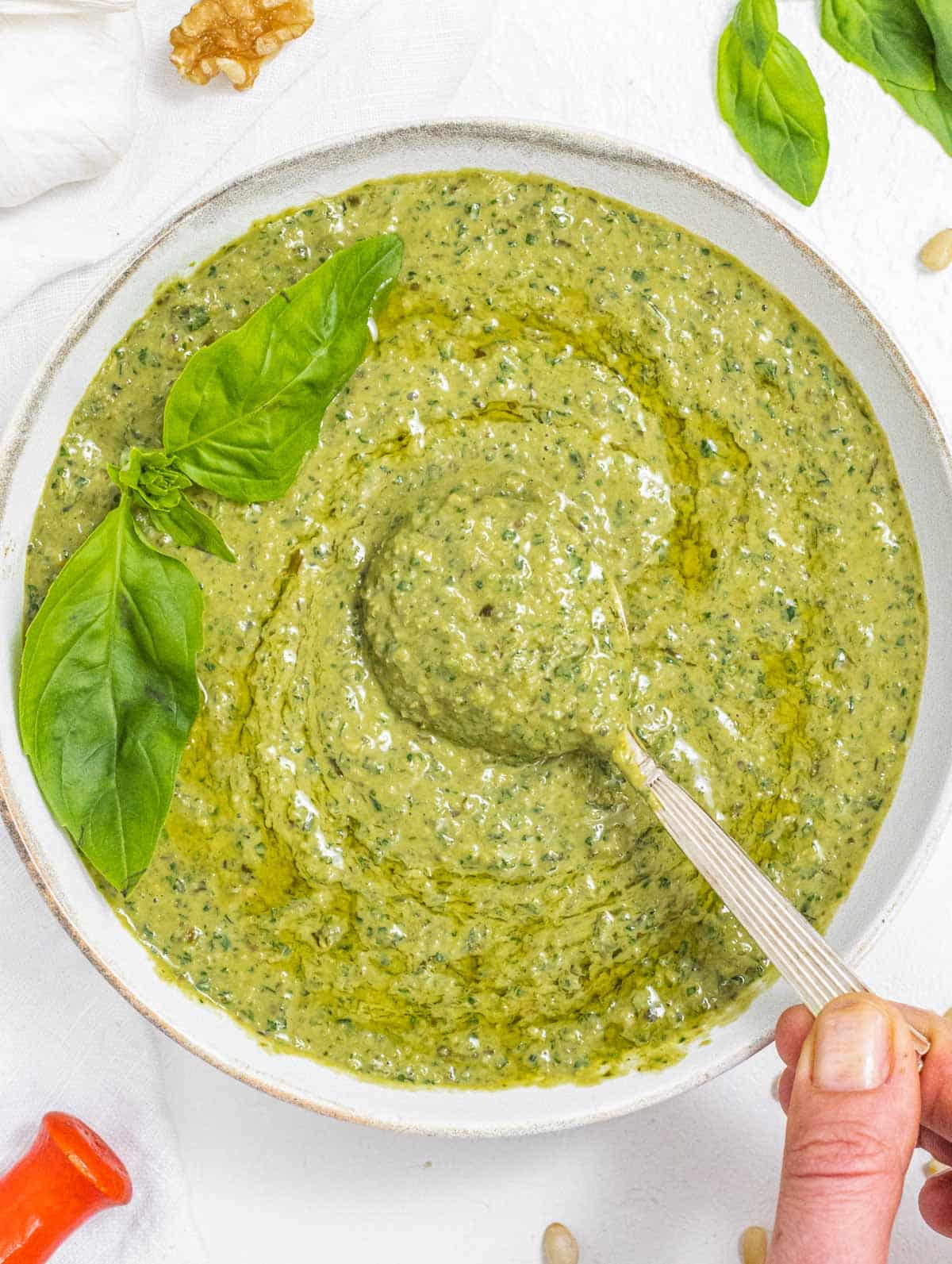
Table of Contents
The original pesto recipe originates in Italy, specifically in Liguria, a small region in the northwestern part of the country.
It dates back a few hundred years (around 1700 – 1800) and has been evolving ever since.
Back then, especially among the farmers, pesto was made with simple and economical ingredients, such as local sheep’s cheese, leftover cheese crusts, plenty of garlic, and walnuts.
It was rare for people to use Parmigiano Reggiano, Sardinian Pecorino, and pinenuts used in the modern pesto recipe as these ingredients were hard to find and expensive.
The modern Italian tradition of pesto, however, calls for very specific ingredients such as basil leaves grown in Pra’ (a Genovese neighborhood), extra virgin olive oil made in Liguria, pine nuts harvested in Pisa (the town with the leaning tower), Parmigiano Reggiano aged 30 months or more, Fiore Sardo (a 10-month old Sardinian sheep’s cheese), garlic from Vesaslico (a small town known for its garlic), and coarse sea salt from Sicily.
Also, authentic Genoese pesto is prepared in a marble mortar with a wooden pestle (from which the name comes).
Undoubtedly, Pesto alla Genovese is delicious but exclusive, and very few lucky people will ever try it in its authentic form.
Why did we tell you all that?
We think that before trying to “counterfeit” original recipes and make them vegan, it’s essential to understand the history and origin of a dish and pay tribute to their contribution to our food heritage.
So let’s all have a minute of silence for traditional pesto before we move on to our inauthentically delicious vegan pesto recipe.
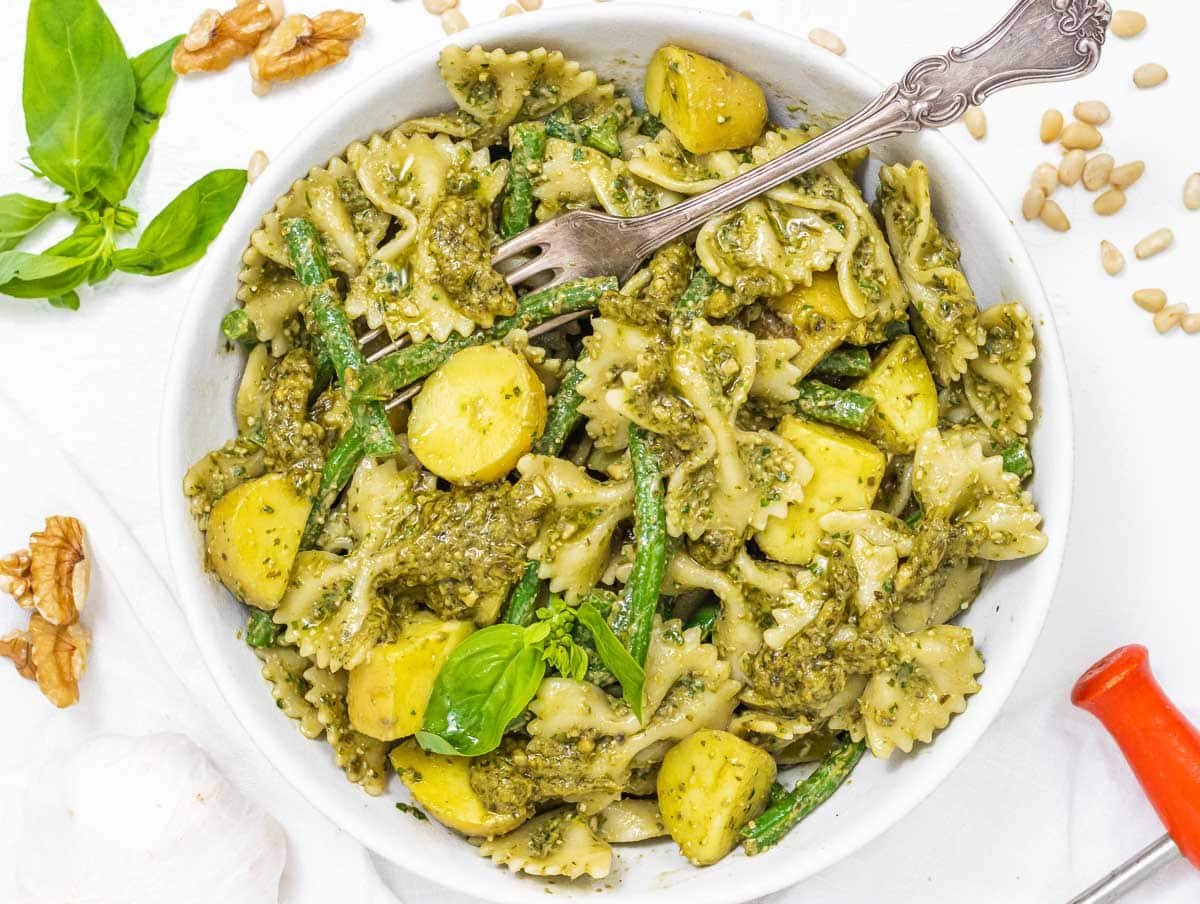
Ingredients
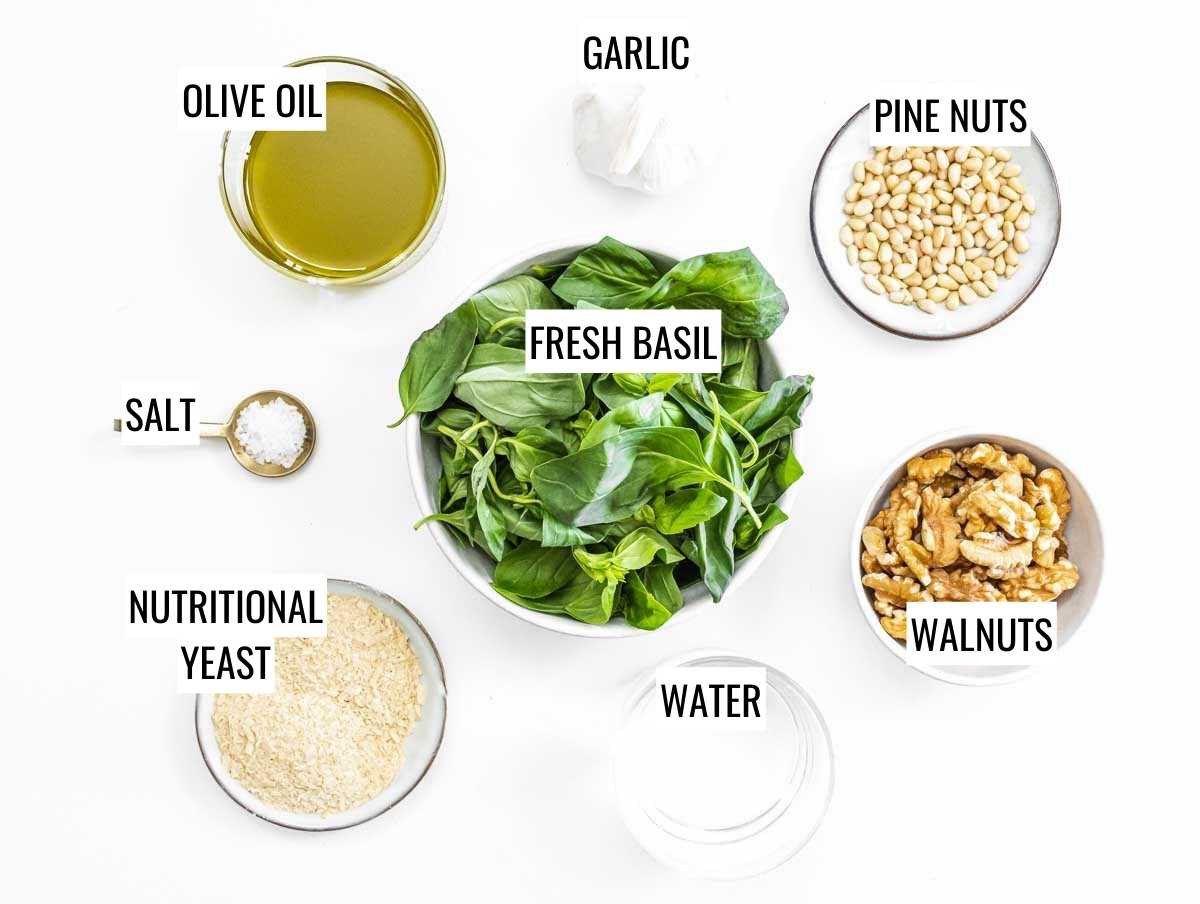
Basil
Fresh basil leaves are the main ingredient in the classic recipe for vegan pesto.
However, you can make variations of this recipe by replacing half of the basil with arugula, zucchini, parsley, or artichoke hearts. See the “variations” chapter below to learn more.
Garlic
Fresh garlic is another crucial ingredient. Add more or less garlic based on your preferences. We use one clove, cut in half lengthwise to remove the core (if any), which can be hard to digest.
Pinenuts
We add a few pinenuts because they give that distinctive pesto creaminess and flavor. Do not toast them.
You can substitute cashew nuts, walnuts, almonds, or macadamia nuts for pine nuts.
Walnuts
We add walnuts to replace the texture and richness of parmesan cheese and make the pesto dairy-free.
Some recipes recommend toasting the walnuts; however, we do not. Toasted walnuts are crunchier and more flavorful, and we don’t want that in our vegan pesto sauce.
Substitute almonds or cashews for walnuts.
Nutritional yeast
Vegan pesto is one of those recipes where nutritional yeast shines.
While the nuts add texture, the nutritional yeast adds a slightly cheesy flavor.
It goes incredibly well with both the nuts and the basil, and we think it’s of great help in replacing parmesan (we even use nutritional yeast and almonds in our vegan parmesan recipe).
Extra virgin olive oil
Extra virgin olive oil is best for this recipe because it has a richer flavor than regular olive or vegetable oil.
However, you don’t need the most expensive oil here since the nuts, garlic, and especially the basil will cover up the flavor of the oil quite a bit.
We tested with one of the best Italian olive oils ever (made by a farmer next door with olives grown on Italian hills and cold-pressed) and a cheaper but still good quality commercial extra virgin olive oil, and we could not tell the difference.
However, do not get the cheapest oil! Also, avoid oils with a bitter aftertaste, as those will ruin your pesto.
For oil-free pesto, check out the “variations” chapter below.
Ice cold water
Ice-cold water has two purposes. First, it cools down the basil in the blender, helping preserve its flavor and bright green color.
Second, I always thought pesto had too much oil, which can be hard to digest. Cutting it with water solves this problem without affecting the flavor.
Salt
Salt is necessary to bring out the flavor of the basil. Sea salt and kosher salt are best for this purpose.
Add more or less based on taste and dietary preferences. However, since we don’t add parmesan and pecorino cheeses, vegan pesto sauce needs more salt than regular pesto to taste good.
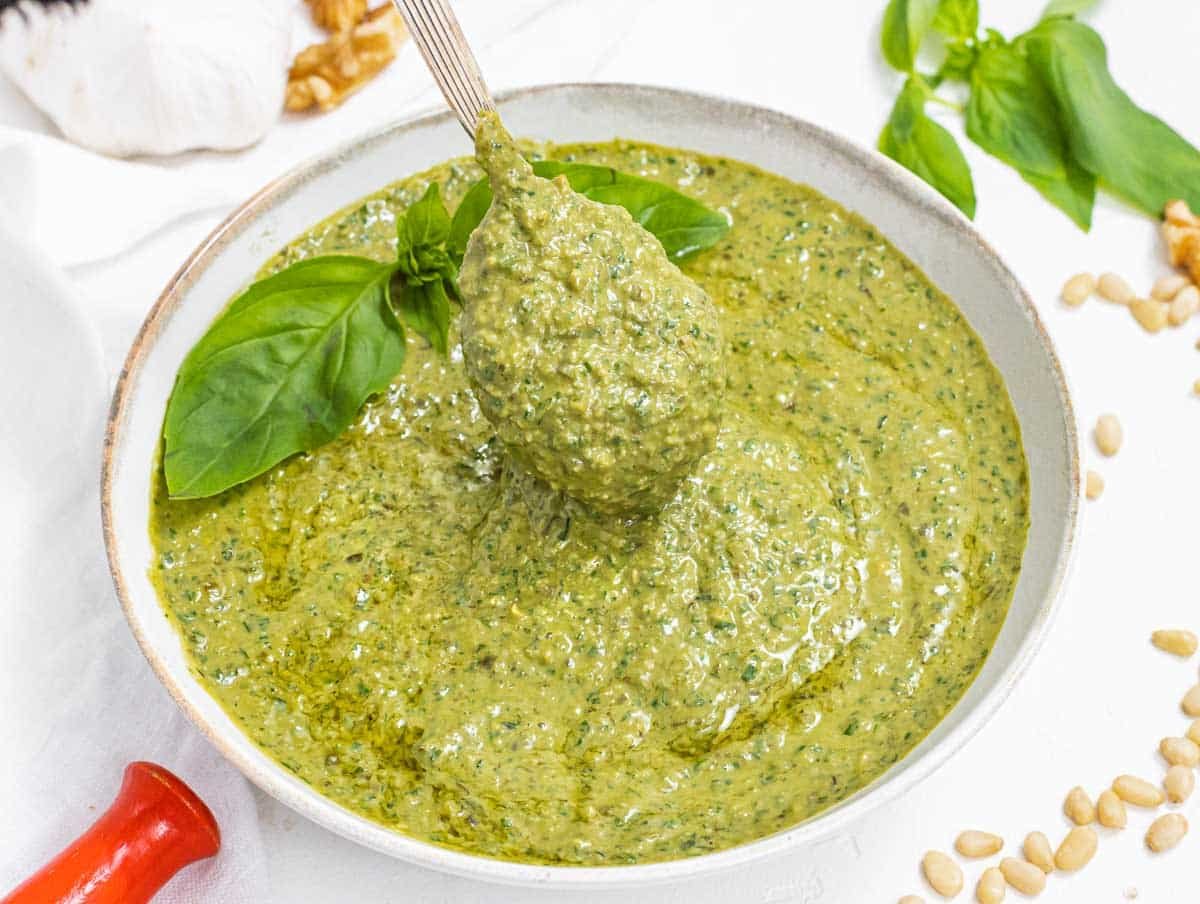
Instructions
Peel and cut the garlic clove lengthwise, and remove the core, if any.
Tip: we find the core of the garlic particularly hard to digest, so we often recommend removing it if it is eaten raw.
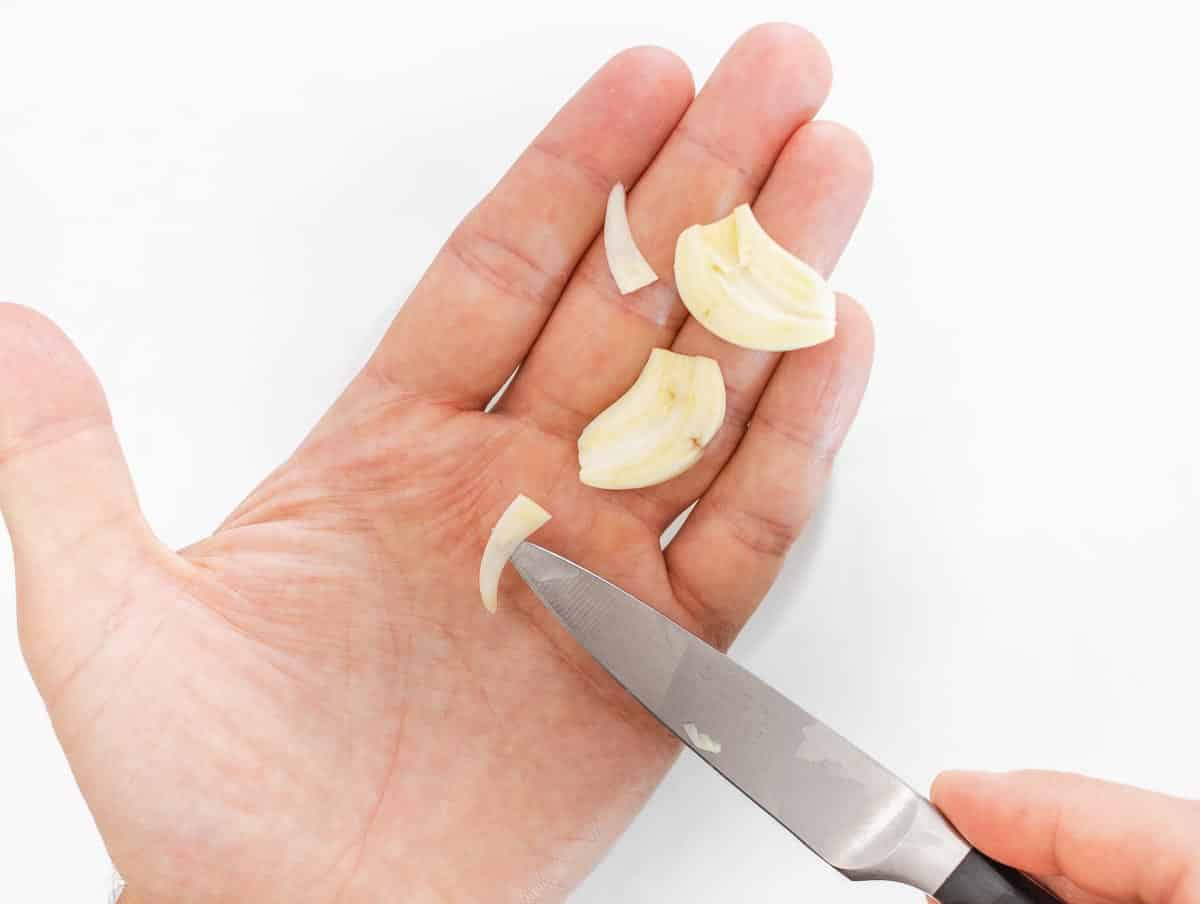
Chop the garlic into small pieces and add it to a small food processor with pine nuts, walnuts, nutritional yeast, and salt.
Blend for about 1 minute or until the ingredients are reduced into coarse flour that vaguely resembles parmesan cheese.
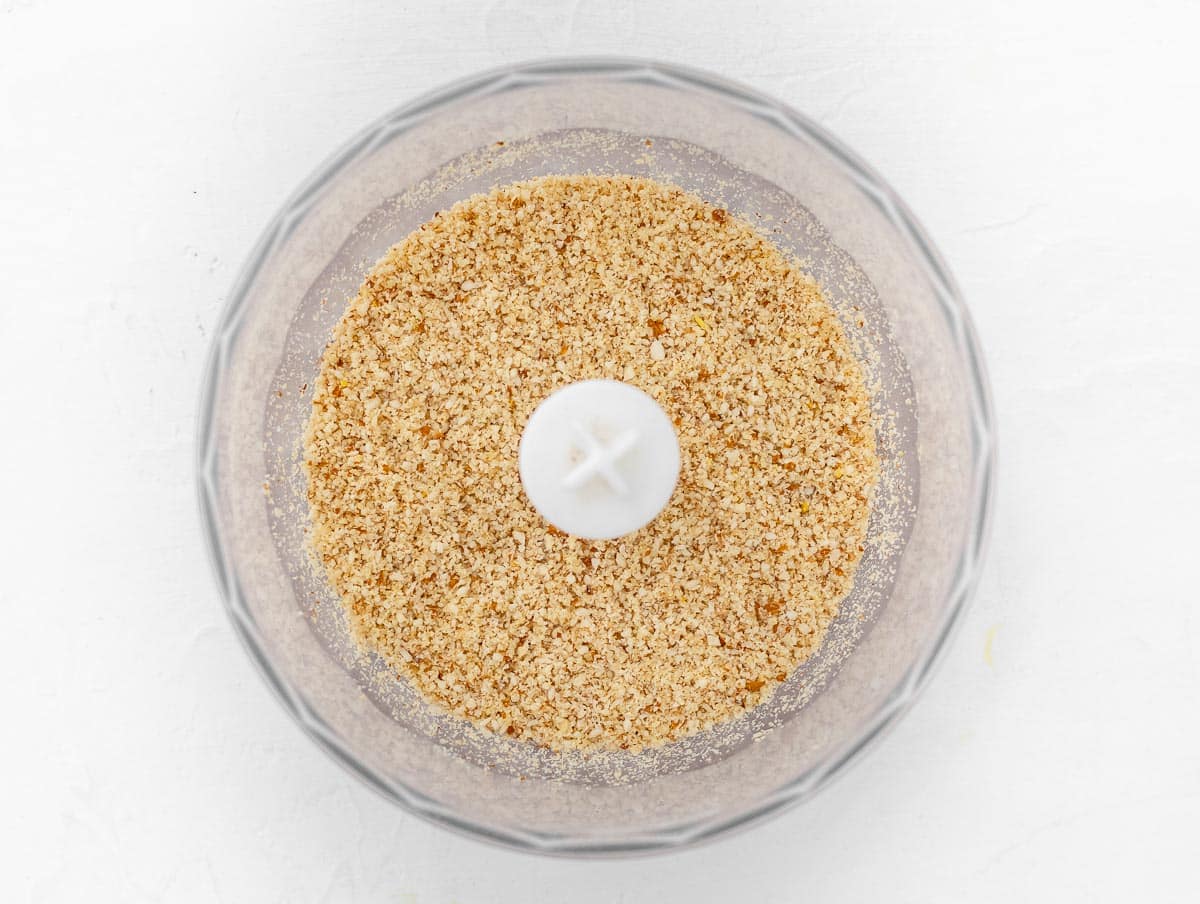
Add the fresh basil leaves, extra virgin olive oil, and ice-cold water.
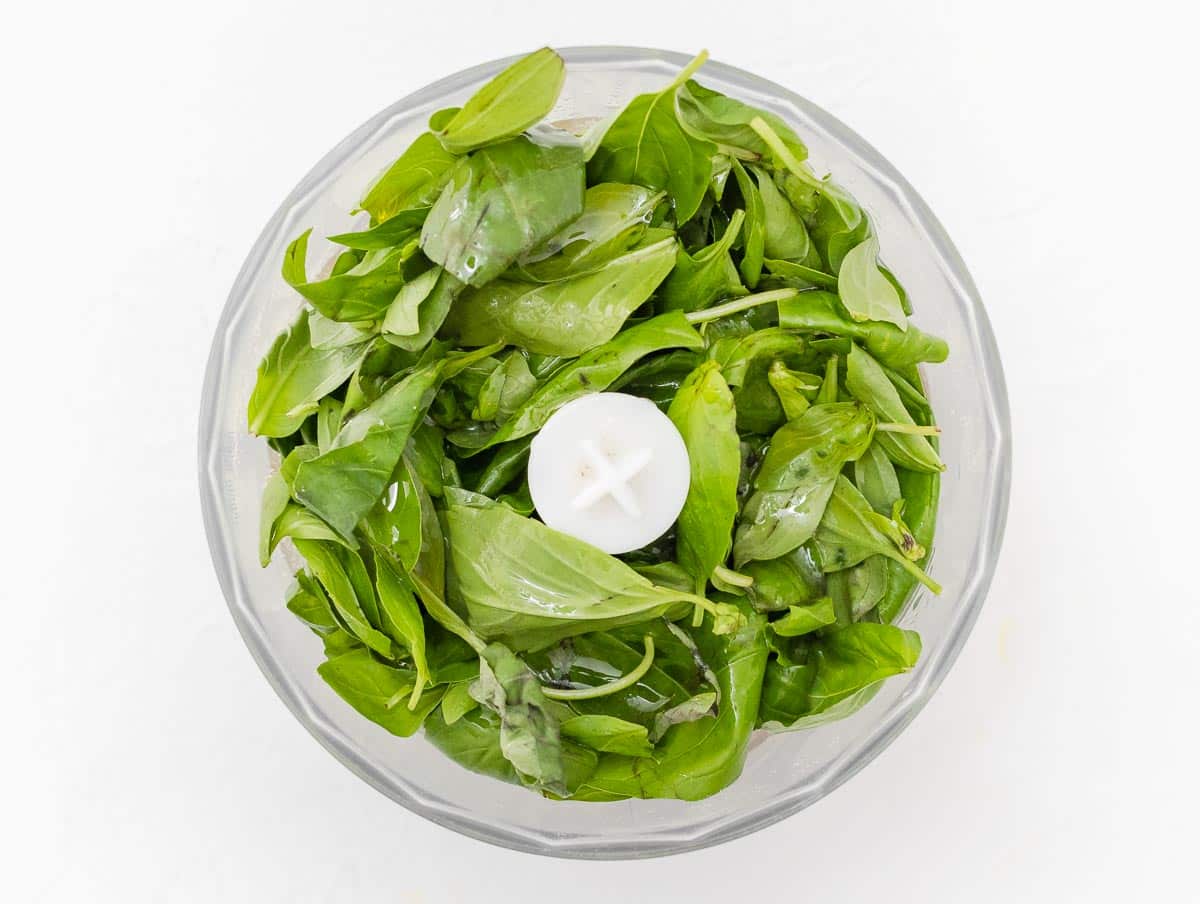
Pulse a few times until the basil is finely minced, and you get a creamy green pesto.
Note: do not blend continuously; this will warm up the basil, which will lose flavor and turn dark. Also, you can adjust consistency based on your preference by adding more water.
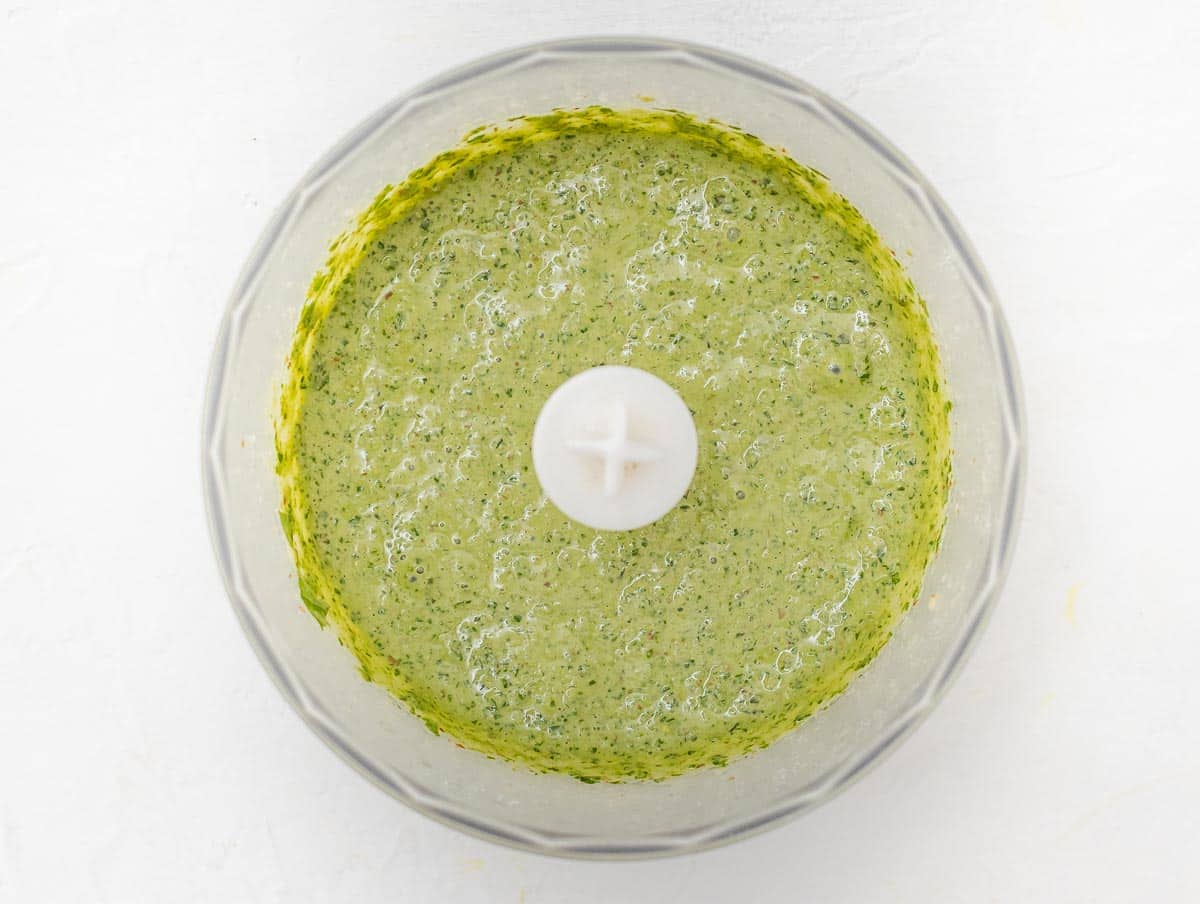
We like to make a fairly thick pesto that we can use as a spread in sandwiches, on toasted bread, or in wraps.
If you want to use it as a salad dressing or pasta sauce, add more water or oil until it’s thin enough.
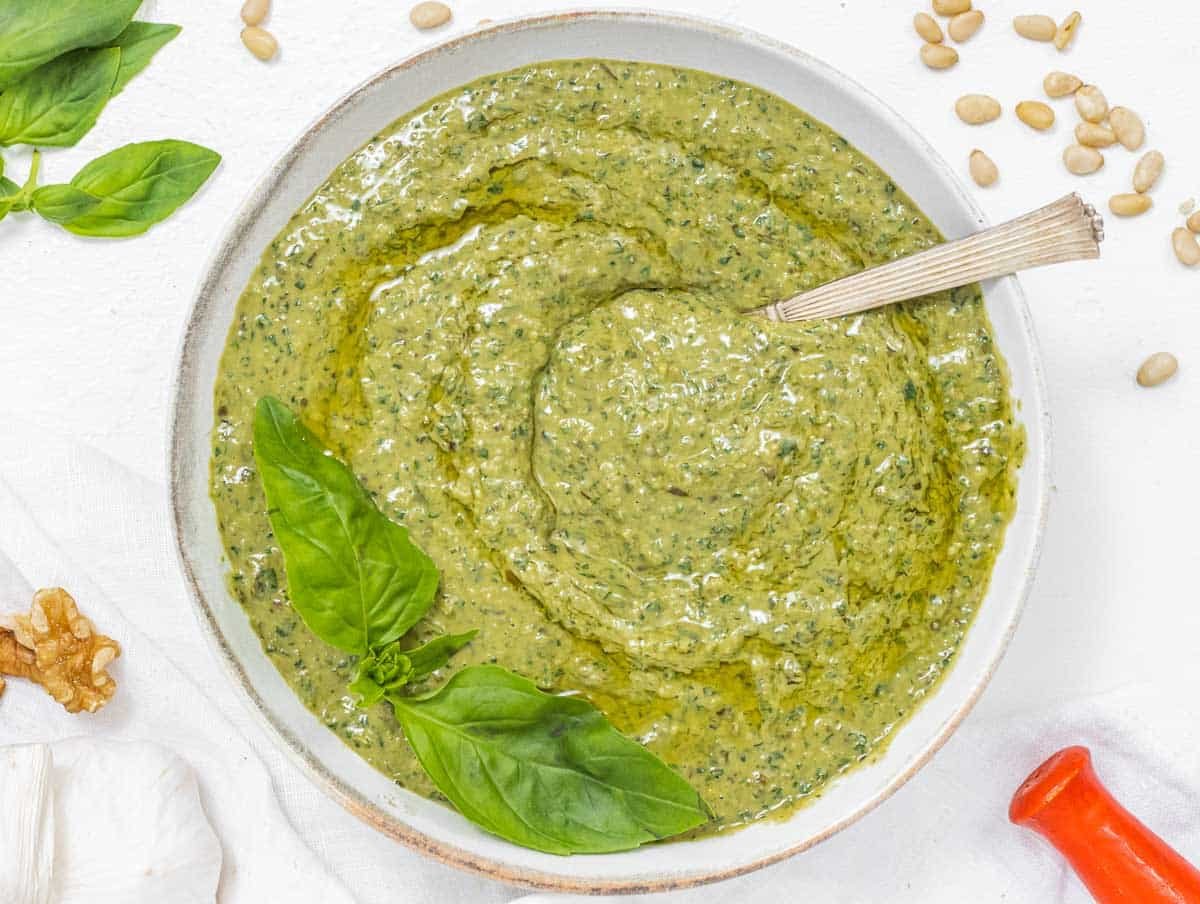
Serving suggestions
You can use vegan pesto as a pasta sauce, spread in a sandwich, dip with veggies, dressing for a salad, topping on pizza and grilled veggies, and more.
Pesto pasta
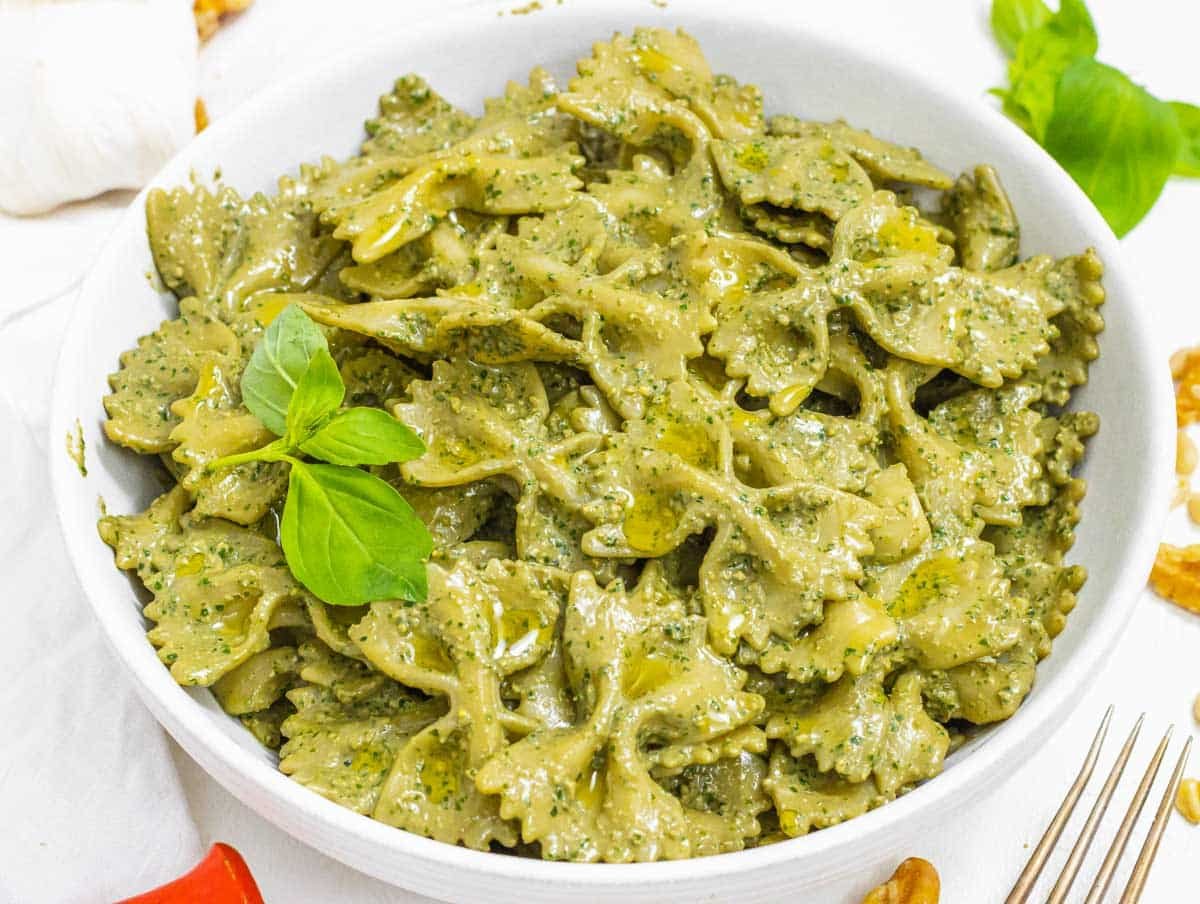
This one’s a classic! First, cook the pasta al dente in plenty of salted boiling water.
While the pasta cooks, add the pesto to a large mixing bowl with 1/2 cup of warm reserved pasta water and stir until you have a creamy pesto sauce.
Drain the pasta, add it to the bowl, and mix well, adding more pasta water if necessary.
Check out our pesto pasta recipe.
Trofie with pesto
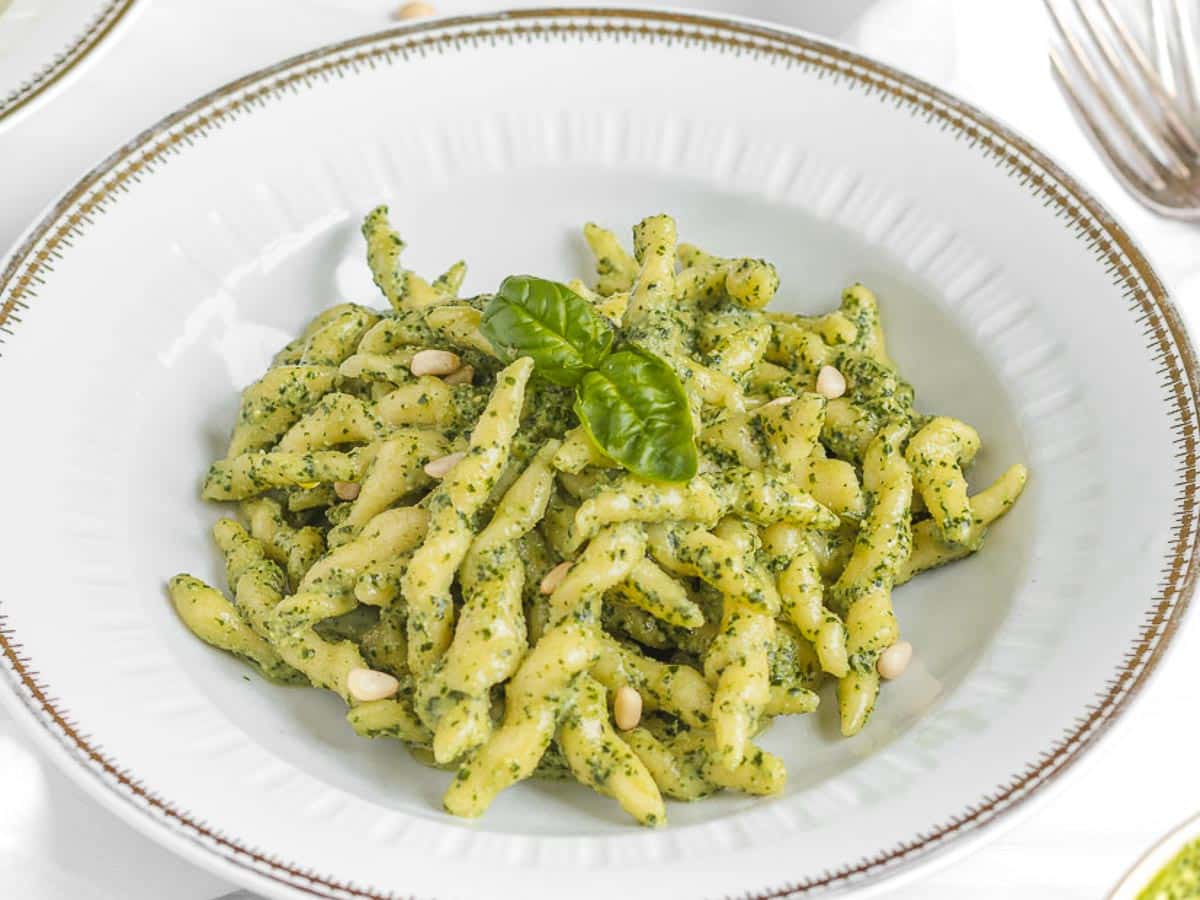
Trofie is a handmade fresh pasta type popular in the Liguria region in Italy, and they are often served with basil pesto.
They are naturally vegan and made with water and semolina flour. If you want to go all-in Italian-nonna cooking mode, check out our homemade Trofie recipe.
Pesto pasta salad
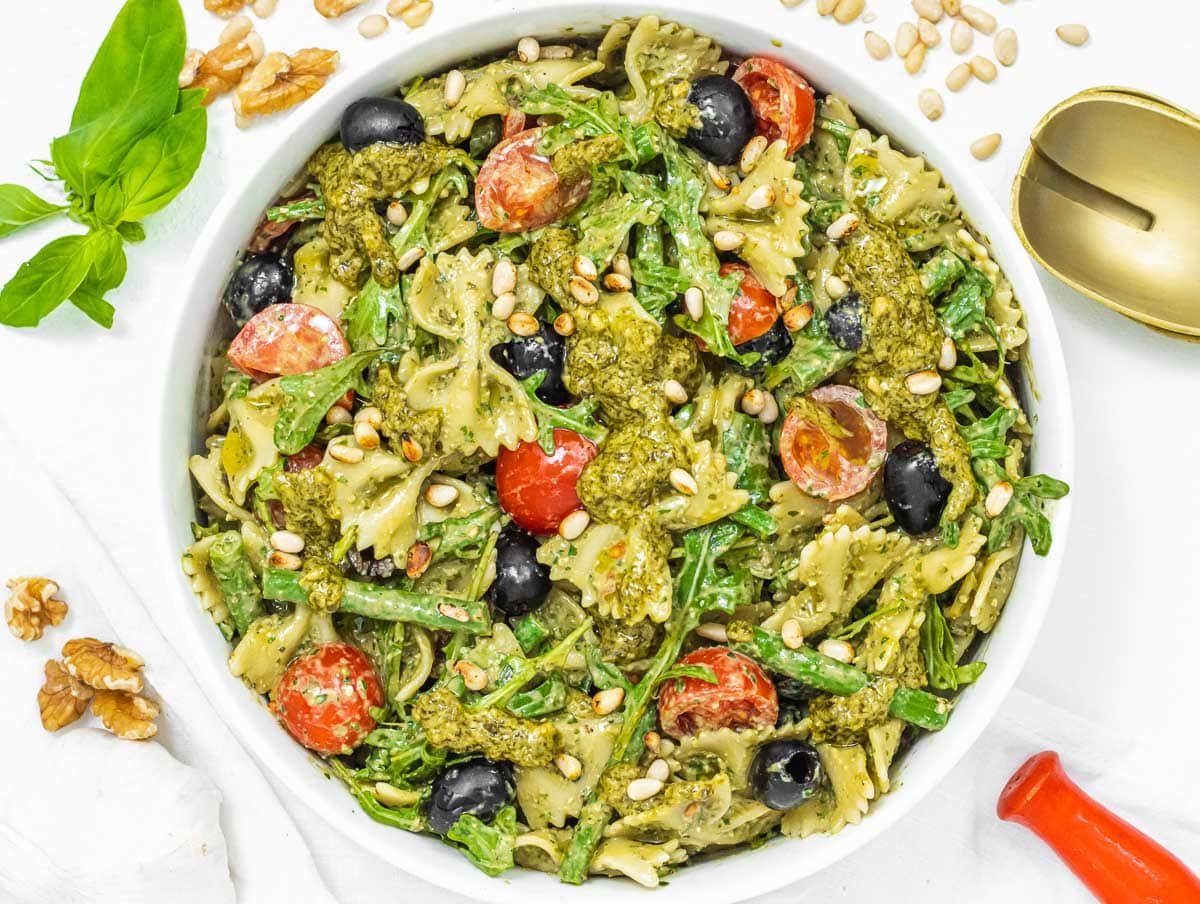
Our vegan pesto is also delicious cold, for example, tossed with pasta to make a colorful and delicious pesto pasta salad.
Check out our pesto pasta salad recipe.
Stuffed eggplants
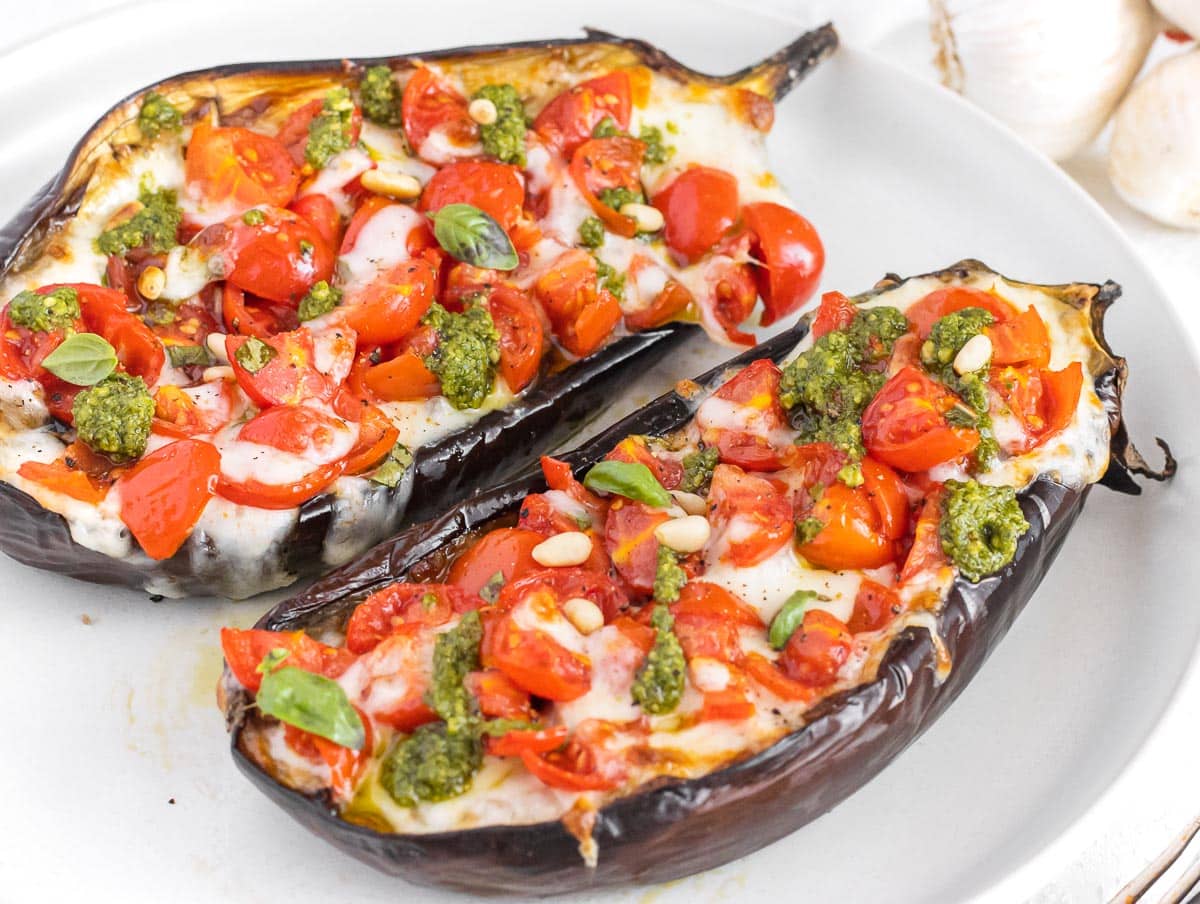
This is the easiest and tastiest stuffed eggplant recipe we’ve ever tried. We make it with fresh tomatoes, mozzarella or vegan cheese, and a drizzle of our vegan pesto.
It’s perfect as an appetizer, main dish, or side dish and is easy to make.
Check out our stuffed eggplant recipe.
Potato Salad
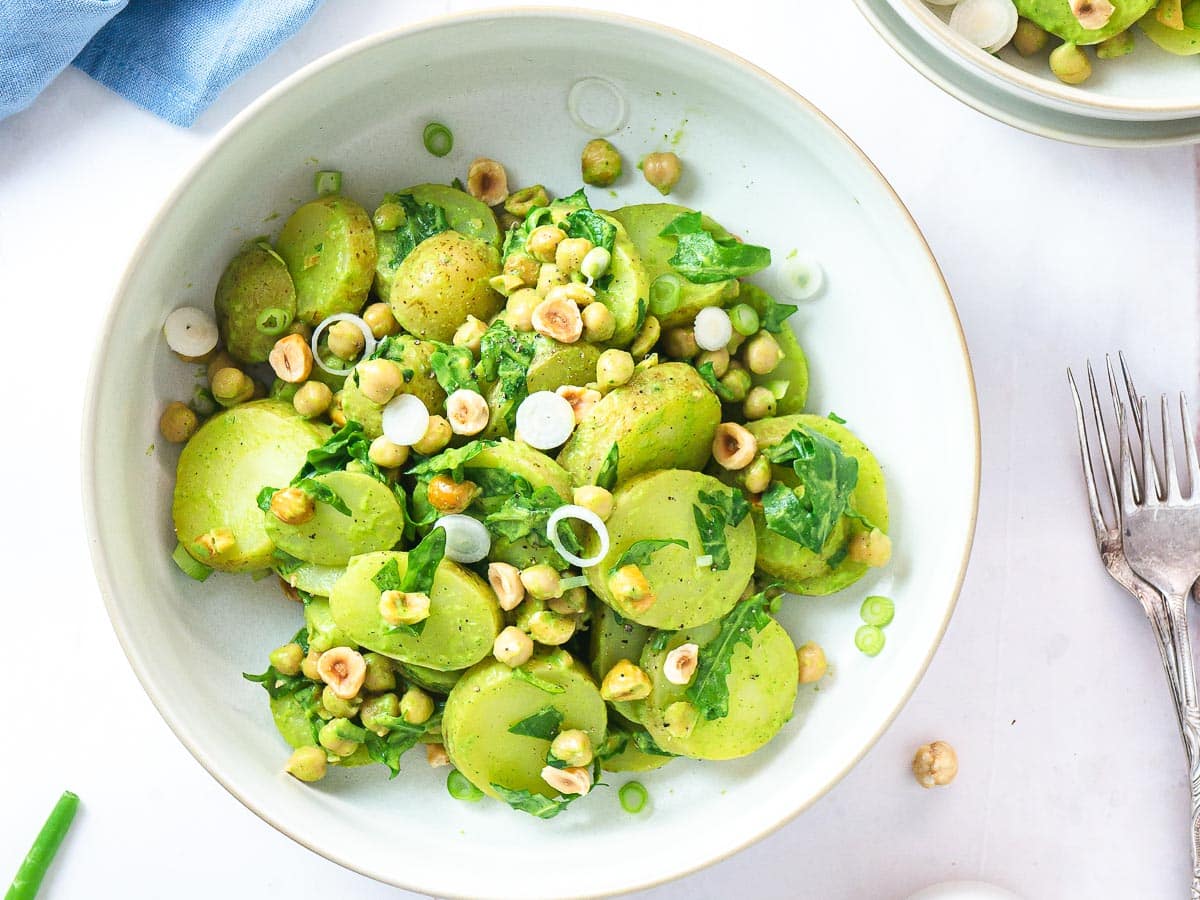
Another traditional way of eating basil pesto is with boiled potatoes and green beans.
We made a delicious vegan potato salad with basil pesto. Check it out. The Italian farmers used to eat pesto like this before eating it with pasta.
Eggplant pizza
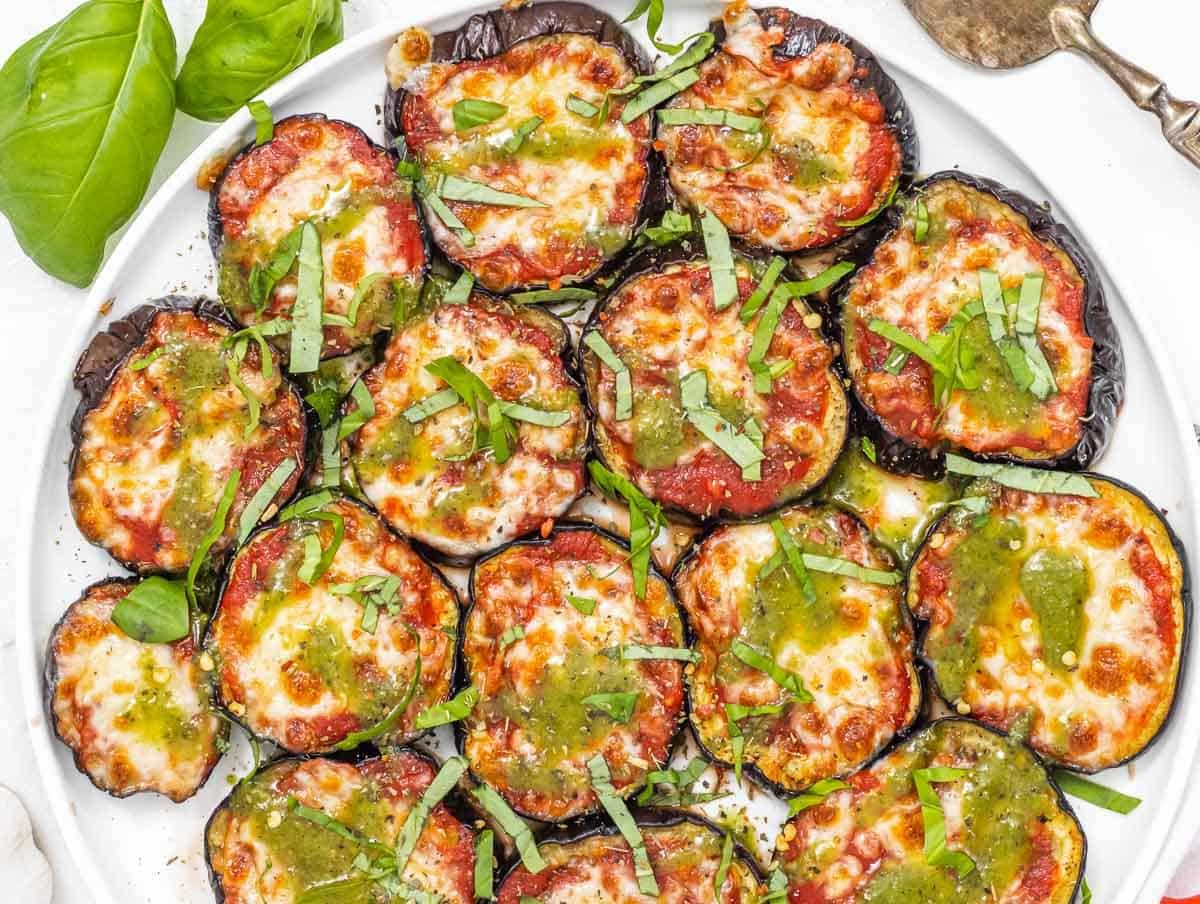
Roasted eggplant slices topped with marinara sauce, melted vegan cheese or mozzarella, oregano, and a drizzle of our delicious vegan pesto!
You are going to love this recipe. It makes a delicious starter to wow your family and friends.
Check out our eggplant pizza recipe.
Flatbread pizza
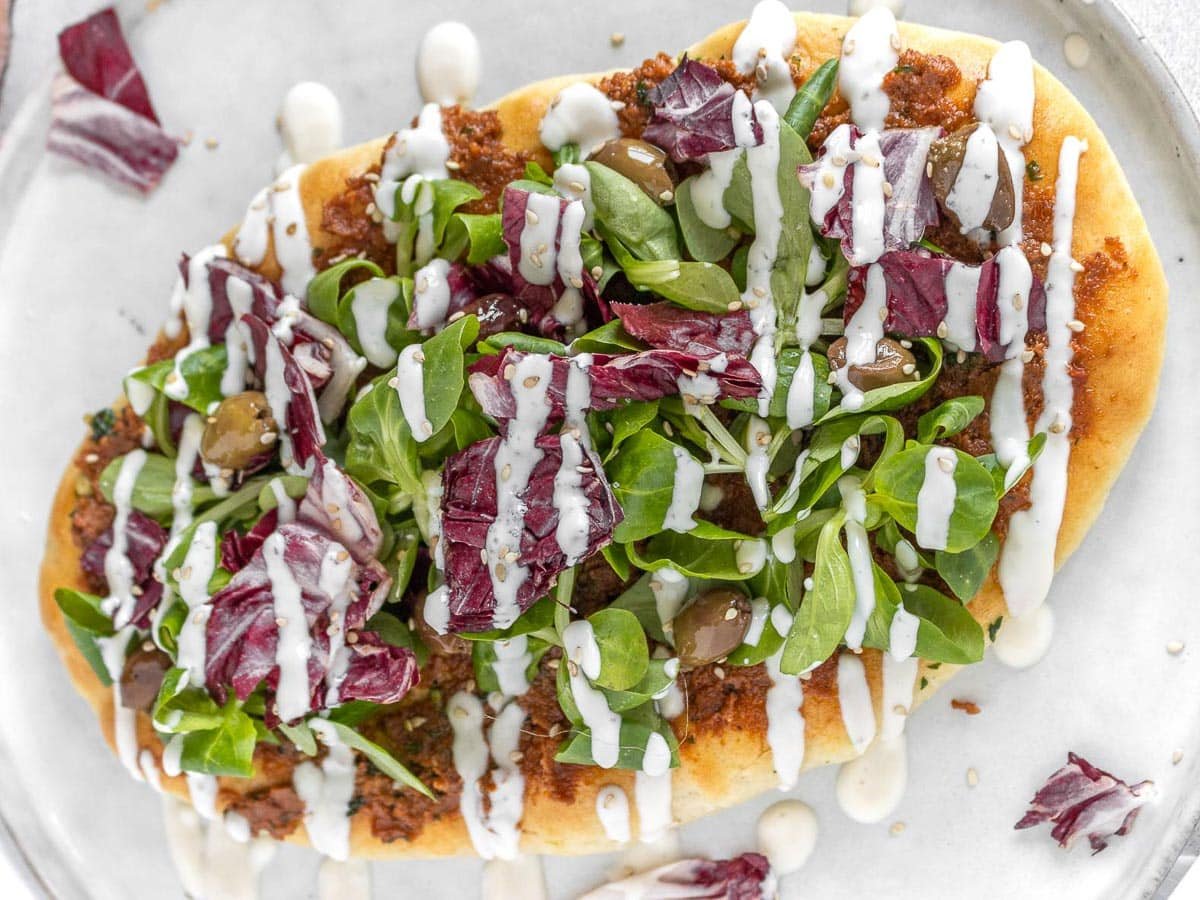
We tried it on our homemade flatbread pizza, and it was sensational. We used our sun-dried tomato pesto in the picture, but any of our vegan pestos will do.
You can make flatbread pizza with simple ingredients and little time at home. No pizza-making skills are required.
Check out our flatbread pizza recipe.
Roasted vegetables
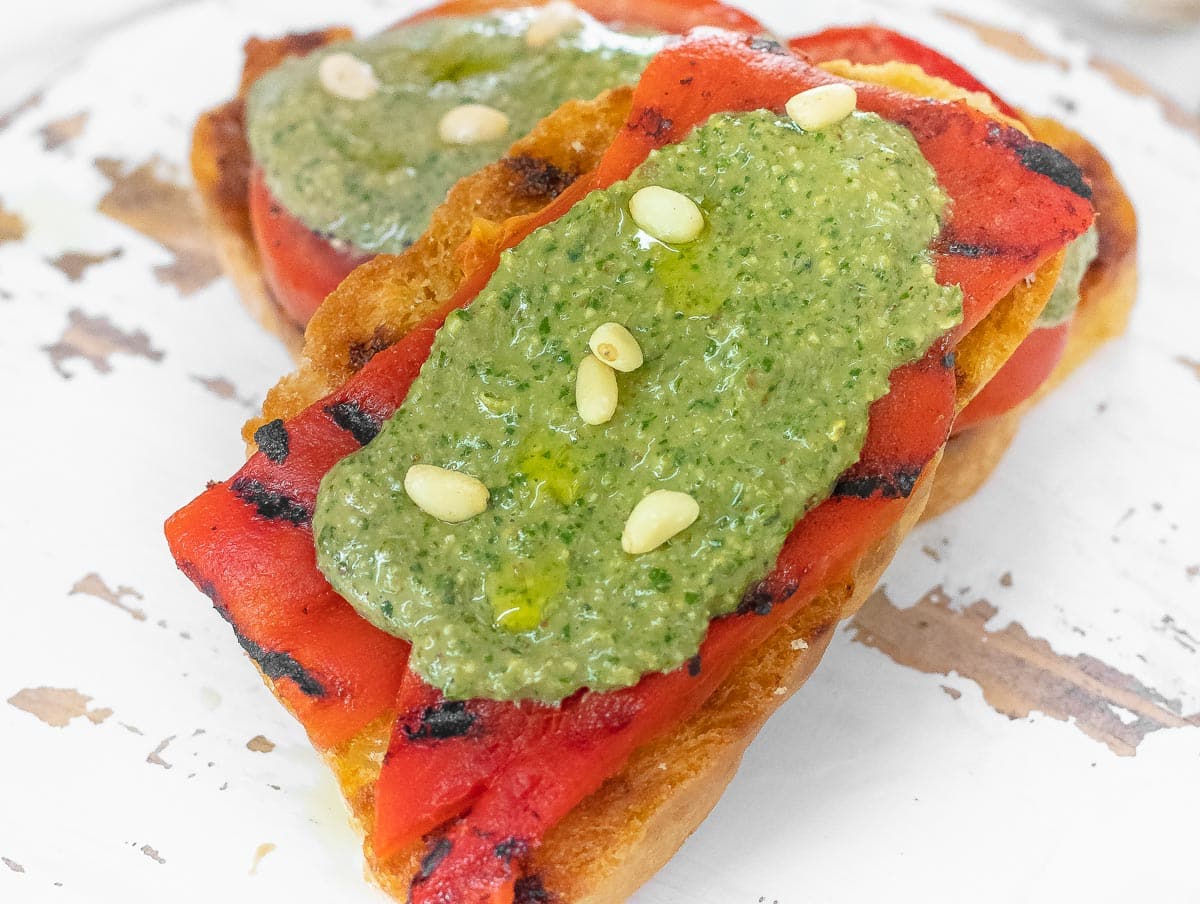
Try drizzling some of the pesto on vegetables. It’s delicious on grilled, air-fried, steamed, and oven-baked veggies.
In the picture below, we add it to grilled bell peppers on a slice of toasted bread.
Bruschetta
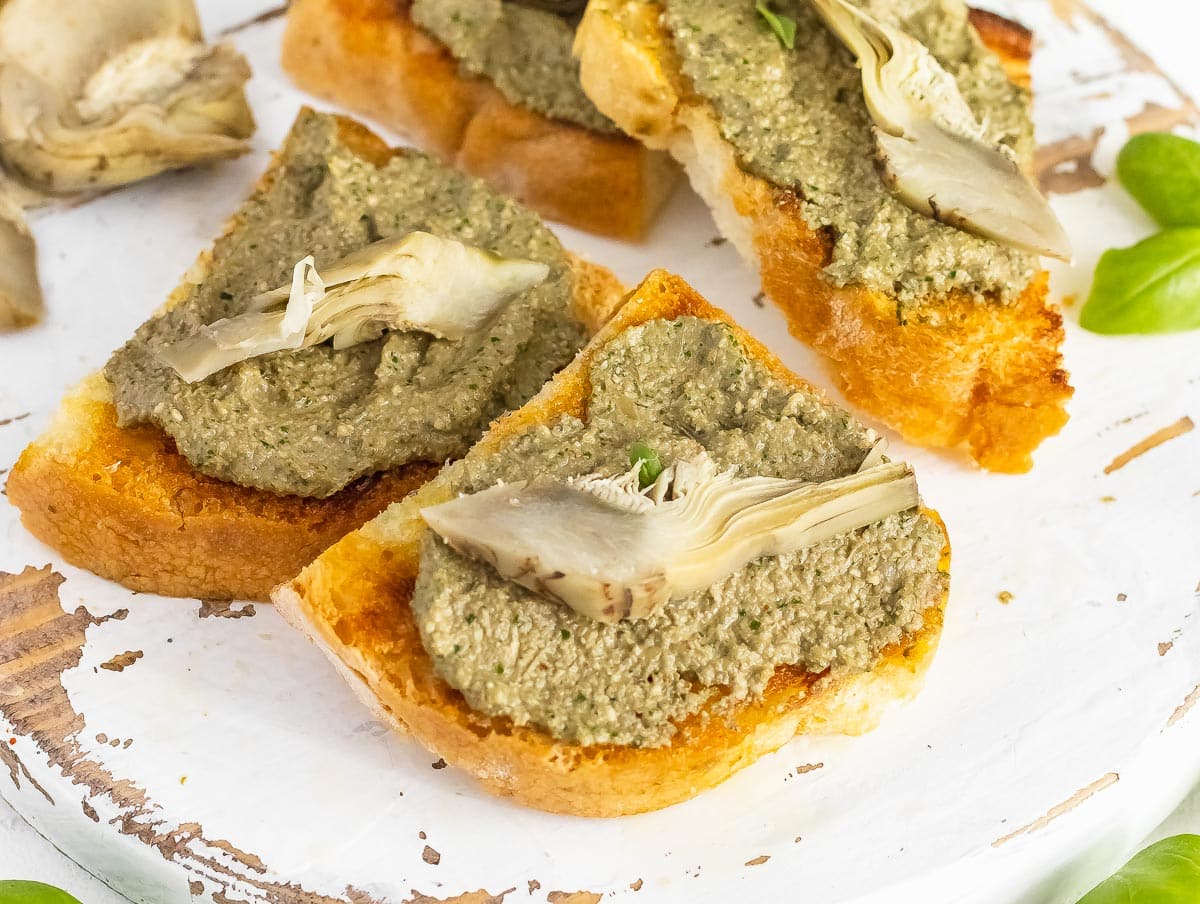
Serve vegan pesto as a starter on bruschetta (crunchy grilled bread with olive oil). We used our artichoke pesto in the picture, but any other type works.
Check out our bruschetta recipe.
Variations
Basil isn’t the only herb to make pesto. If you feel like trying something different, here are some pesto ideas for you. They are all easy, vegan, and delicious.
- Zucchini pesto
- Kale pesto
- Parsley pesto
- Artichoke pesto
- Arugula pesto
- Spinach pesto
- Red pepper pesto
- Sun-dried tomato pesto
- Chestnut pesto
Sauces
Kale Pesto
Sauces
Sun-Dried Tomato Pesto
Sauces
Artichoke Pesto
Sauces
Parsley Pesto
Sauces
Red Pepper Pesto
Sauces
Zucchini Pesto
Sauces
Arugula Pesto
Oil-Free Pesto
You can make a delicious pesto completely oil-free. To do so, the star ingredient is macadamia nuts.
Macadamia nuts are packed with healthy fats to help replace the oil. In addition, when blended, macadamia nuts get super creamy, almost dairy-like.
You won’t need any oil or almonds when making pesto with macadamia. The other ingredients stay the same. Use 1 cup of macadamia nuts. Add more water as necessary to make the pesto of the right consistency.
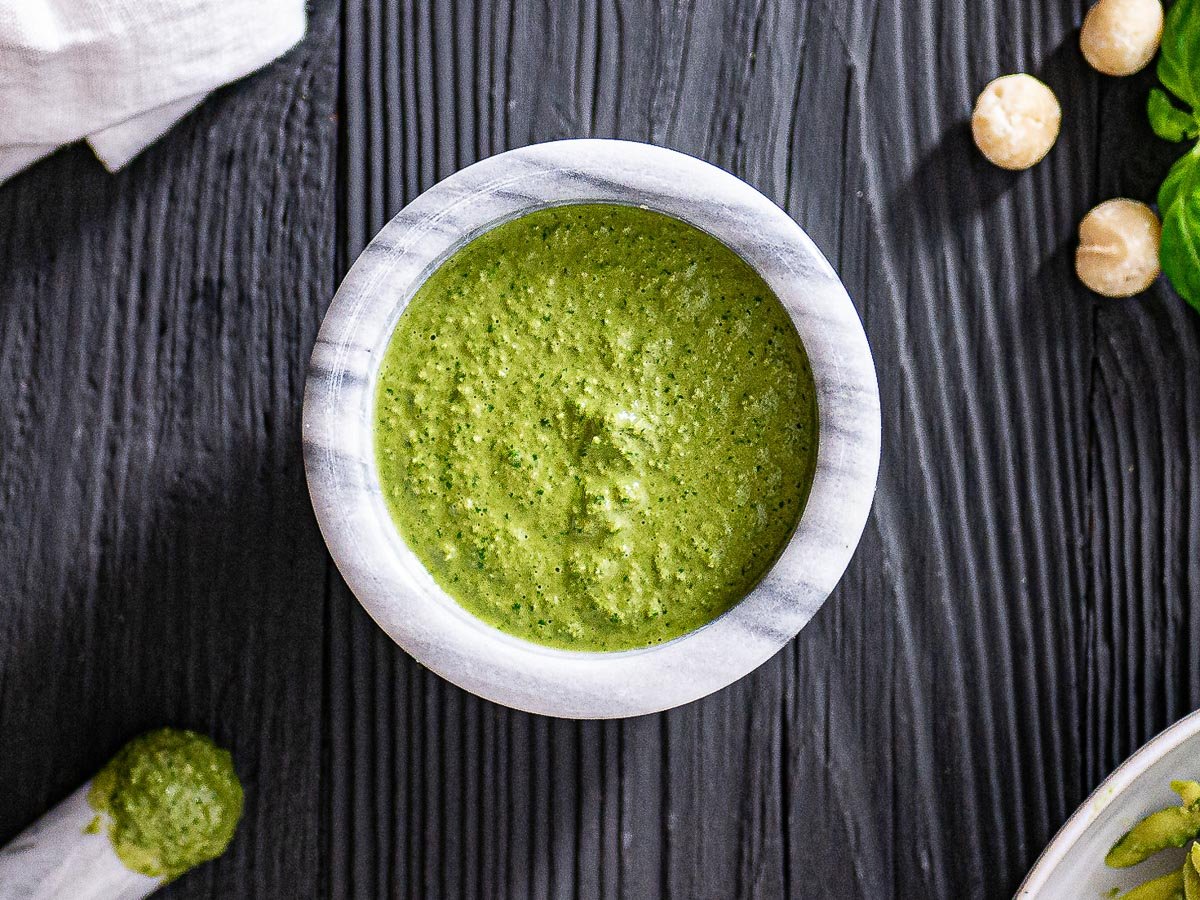
Tips
No need to toast the nuts.
Toasting nuts is unnecessary when making pesto, and we discourage it. It is not done in the original Italian recipe and should not be done in vegan pesto. Why?
Toasting nuts increases the flavor of the nut, and we don’t want that in a pesto. Instead, we want to taste the basil. Also, toasted nuts are crunchy; we don’t want that either.
Finally, if you toast the nuts, they would have to cool down entirely because warm nuts would damage the basil. You would turn vegan pesto from a 5-minute recipe into a 2-hour project with questionable results.
What about blanching the basil?
That’s another unnecessary practice for pesto. Blanching is a cooking method where the vegetable is scalded in boiling water for a few seconds, then cooled down in an ice bath to stop the cooking.
Blanching does help preserve the quality of vegetables and their color because it deactivates the enzyme responsible for oxidation.
Oxidation happens when the polyphenols in basil (antioxidants) react with air (oxygen) and turn brown (oxidize). Like when you cut an apple and leave it out in the air.
Another element that speeds up oxidation is moderate heat, up to around 190°F or 90°C. Above that temperature, the enzymes that oxidize the basil are deactivated.
That’s why the blanching argument. Technically, blanching does keep the pesto green for longer, but at the cost of reducing its flavor, especially if done incorrectly.
Basil is an extremely delicate herb that loses flavor quickly when heated up. And so we do not recommend it. That’s also why we do not recommend heating the pesto on a pan.
Also, I have never seen my Italian nonna blanch basil when making pesto, and hers was pretty good.
Instead, we recommend adding iced water to the food processor to keep the basil cool while it blends. The low temperature will slow oxidation, and the basil will stay greener for longer.
Then when the pesto is ready, you’ve got to keep it refrigerated and protected from oxygen. To do that, transfer it to a jar, cover it with a thin olive oil, and put it in the fridge (or freezer).
Pulse
Blending continuously will heat the basil; we don’t want to do that. Basil doesn’t like heat (see the previous tip). Pulse instead.
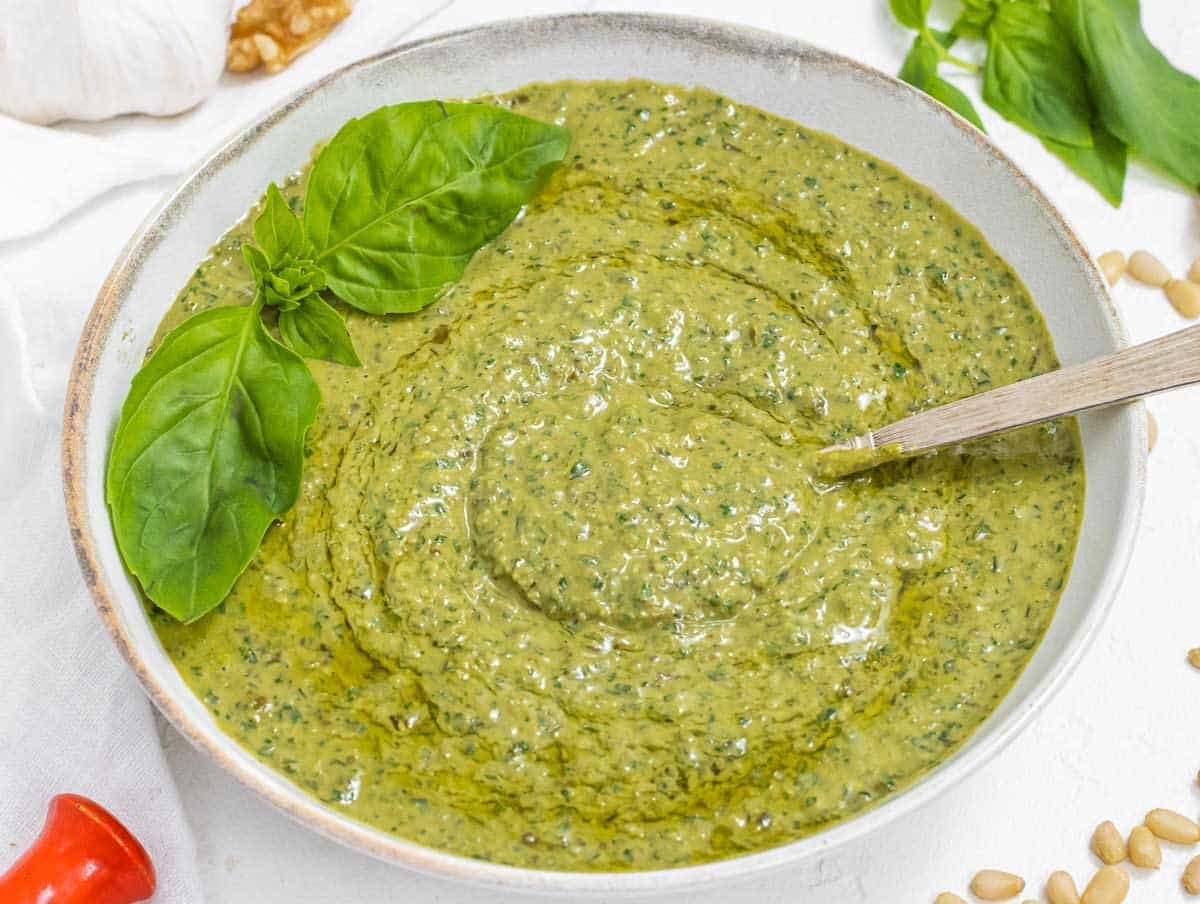
Questions
Traditional basil pesto sauce is not vegan because it contains parmesan cheese. Technically, parmesan is not vegetarian either because it contains rennet, extracted from calves’ stomach lining.
You can substitute blended almonds and nutritional yeast for parmesan in vegan pesto.
Nutritional yeast is a deactivated yeast used in vegetarian and vegan cooking as a flavor enhancer, often combined with other ingredients to mimic the cheese flavor.
Make Ahead & Storage
Make ahead: you can make the pesto ahead of time, for example, when fresh basil is in season, then refrigerate it or freeze it to keep it fresh, bright, and flavorful.
Refrigerator: transfer the vegan pesto to a small jar, cover it with a thin layer of extra virgin olive oil, seal it, and store it in the fridge for up to 5 days.
Freezer: Pesto freezes well for up to 6 months. Put it in a small jar or in ice cube trays to have smaller portions at hand.
Thawing depends on use. If you use it with pasta, throw it in a mixing bowl and melt it with 1/2 cup of pasta cooking water. Thaw it in the refrigerator overnight if you use it as a spread.
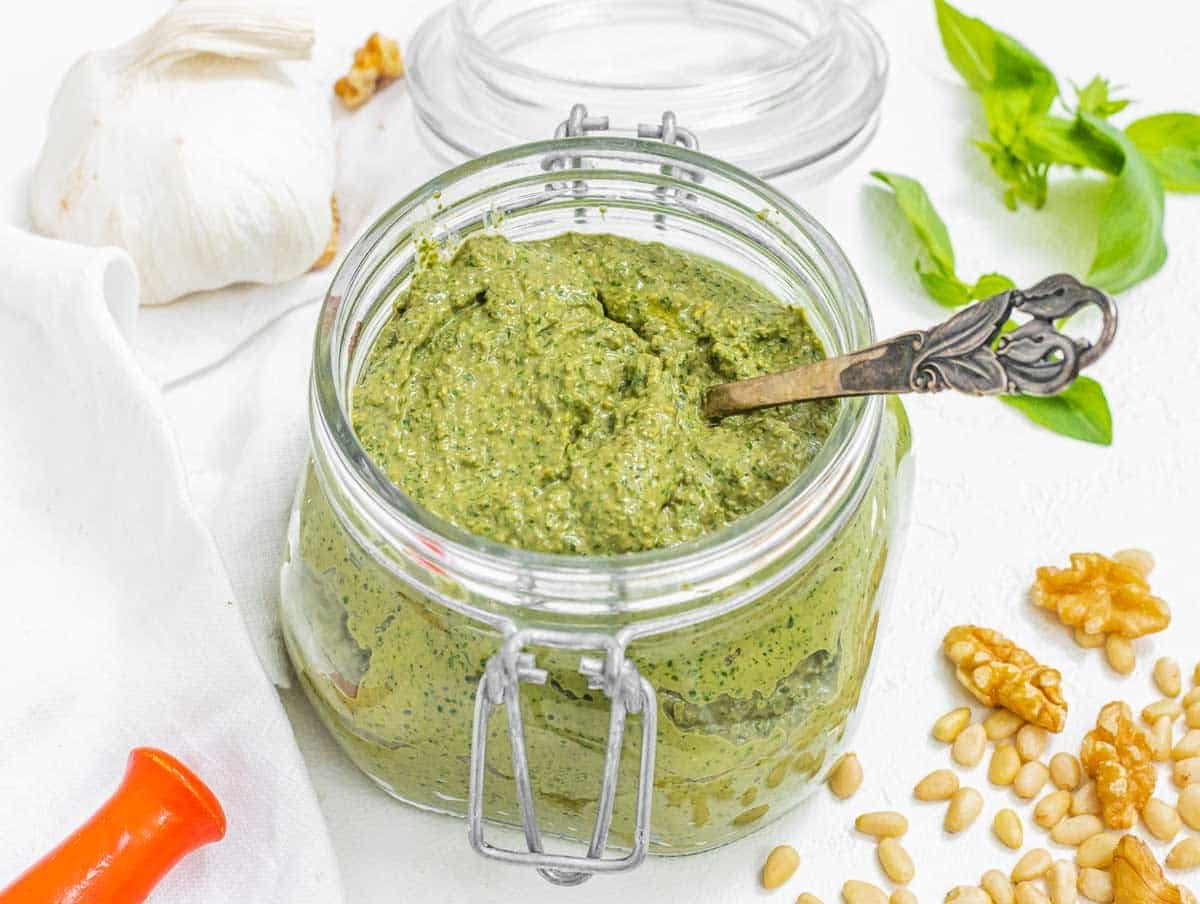
More Sauce Recipes
For more creamy and easy-to-make sauces, try these tasty recipes:
- Tahini sauce (garlic, lemon juice, tahini, water, salt, etc.)
- Marinara sauce (crushed tomatoes, garlic, onion, fresh basil, oregano, etc.)
- White sauce (milk, flour, butter, nutmeg, salt, etc.)
- Romesco sauce (roasted pepper, sun-dried tomatoes, garlic, paprika, almonds, etc.)
- Tzatziki (cucumber, yogurt, garlic, mint, olive oil, salt, etc.)
- Chipotle sauce (sour cream, lime, garlic, mayo or vegan mayo, etc.)
For more condiment ideas, check out our dressing and sauces category page.
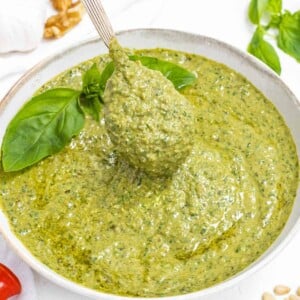
Vegan Pesto
Equipment
- Food processor or blender – we recommend a small one
Ingredients
- 1 clove of garlic
- ⅓ cup of walnuts
- 2 tablespoons of pine nuts
- 4 tablespoons of nutritional yeast
- ½ teaspoon of salt
- 2 packed cups of basil leaves
- ¼ cup of cold water
- ¼ cup of extra virgin olive oil
Instructions
- Peel and cut 1 clove of garlic lengthwise, and remove its core, if any.
- Chop the garlic into small pieces and add it to a small food processor with ⅓ cup of walnuts, 2 tablespoons of pine nuts, 4 tablespoons of nutritional yeast, and ½ teaspoon of salt.Blend for 1 minute or until the ingredients are reduced into coarse flour.
- Add 2 packed cups of basil leaves, ¼ cup of cold water, and ¼ cup of extra virgin olive oil.
- Pulse a few times until the basil is finely minced, and you get a creamy green pesto.
- Use immediately, or store in the refrigerator in a bowl with a thin layer of olive oil on top to prevent it from turning dark. Alternatively, transfer into a small jar and freeze up to 6 months.Tip: never warm up basil pesto with direct heat. It'll change color and lose flavor.
- To use it with pasta, add pesto to a bowl, add ½ cup of pasta cooking water, and stir to dilute it. Reserve some more pasta water for later.Tip: remember to salt the pasta cooking water with a generous amount of salt before cooking the pasta.
- Drain pasta, add it to the bowl with the pesto and stir to combine. Add more reserved pasta water or more pesto if necessary.
Video
Notes
Nutrition
If you liked this recipe, you might also enjoy the following:
Collections
30 Vegetarian Recipes
Collections
25 Vegan Salads
Collections
35 Healthy Pasta Recipes
Collections
25 Easy Sauces
[adthrive-in-post-video-player video-id=”3h8PlCkl” upload-date=”2023-04-15T11:02:34.000Z” name=”Vegan Pesto.mp4″ description=”If you love pesto but want to avoid dairy and animal products, you’re in the right place! Vegan pesto is a delicious and easy way to enjoy the fresh and fragrant flavors of basil, garlic, and nuts.” player-type=”default” override-embed=”default”]

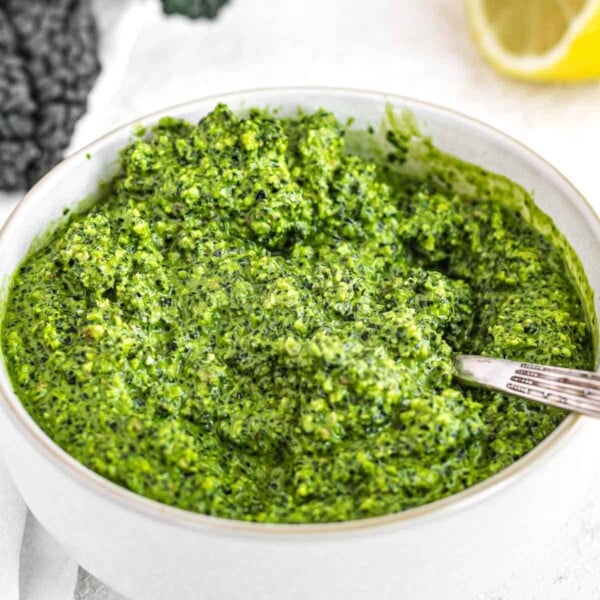
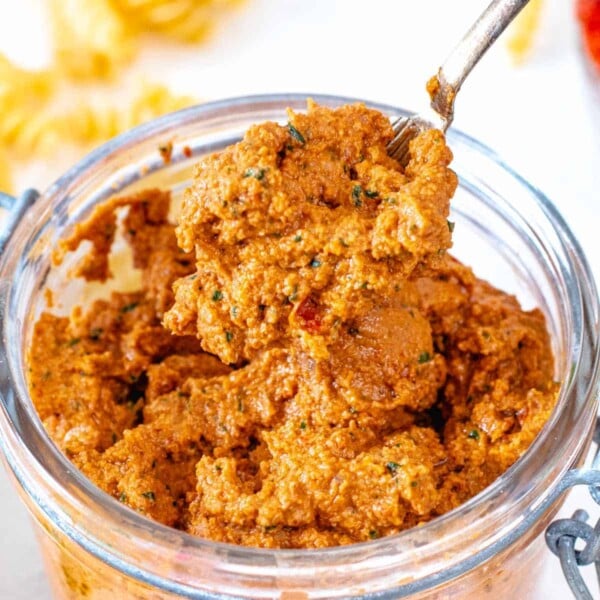
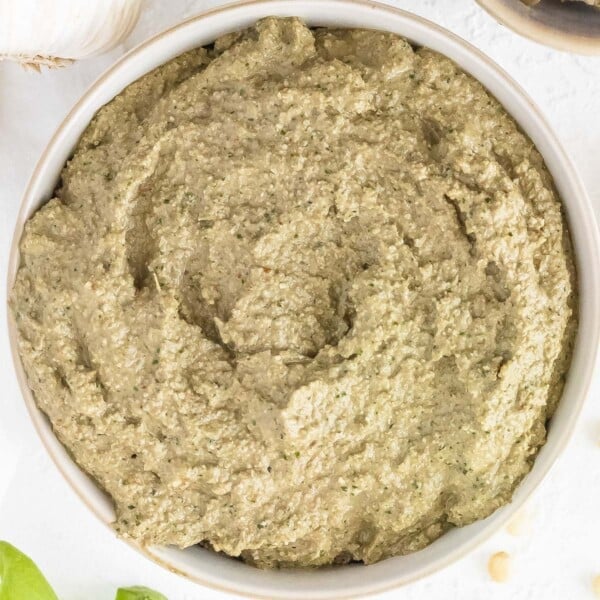
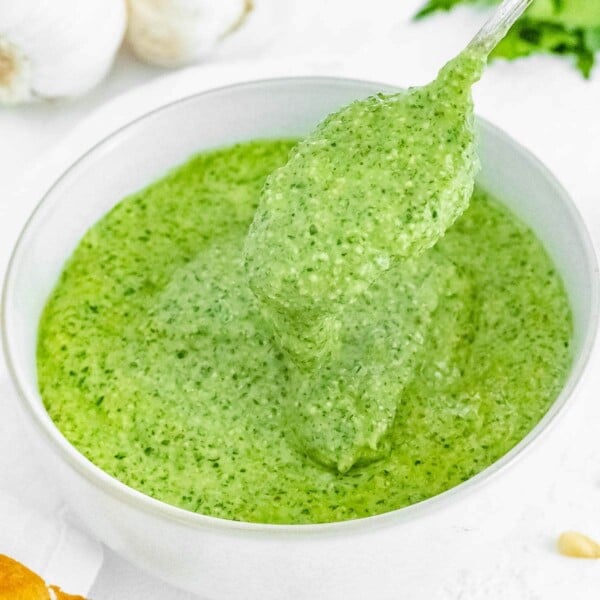
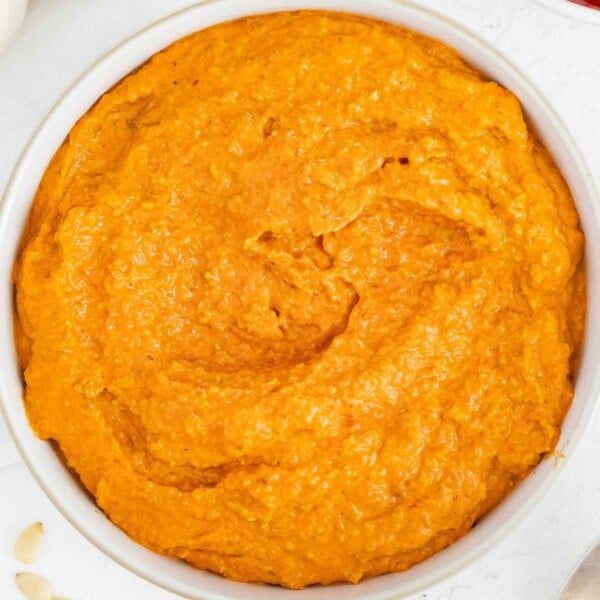
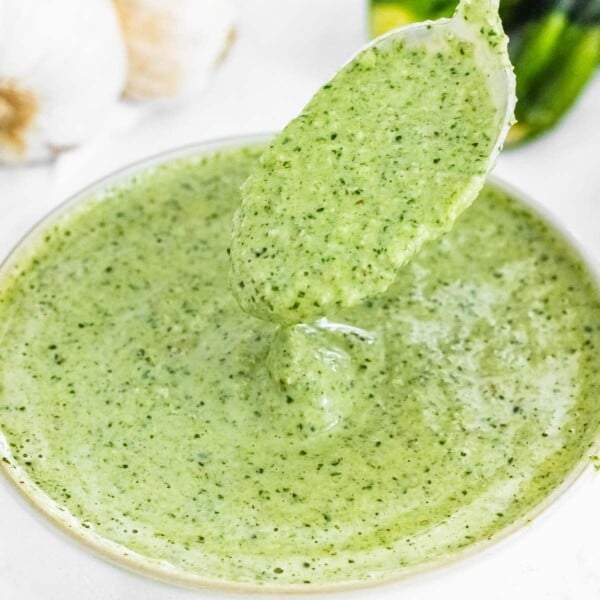
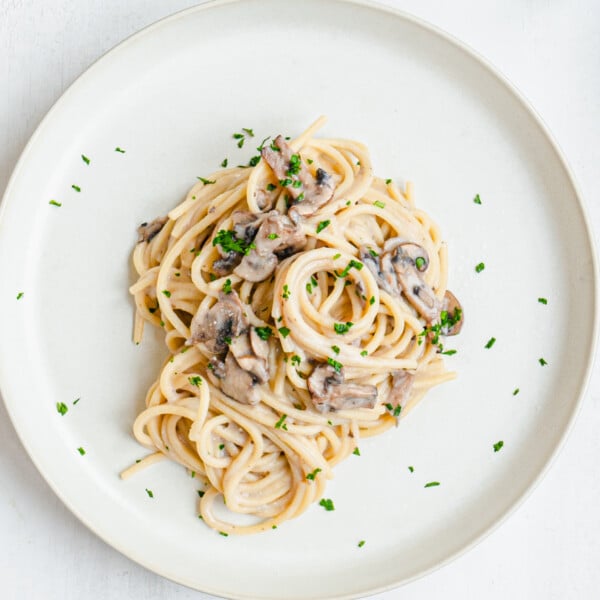
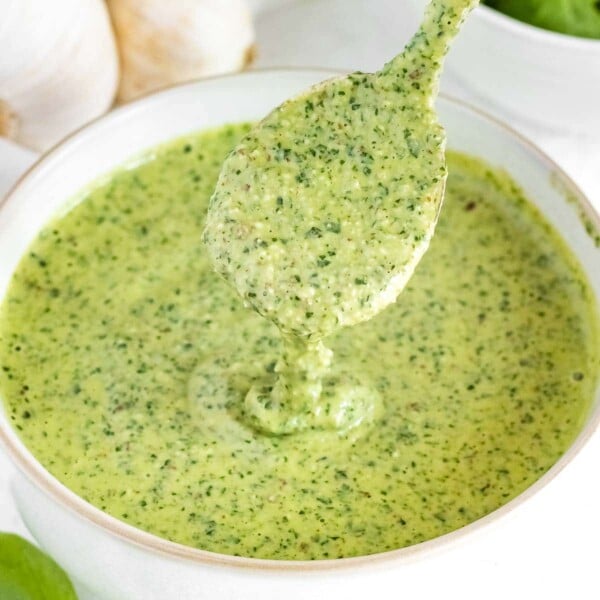
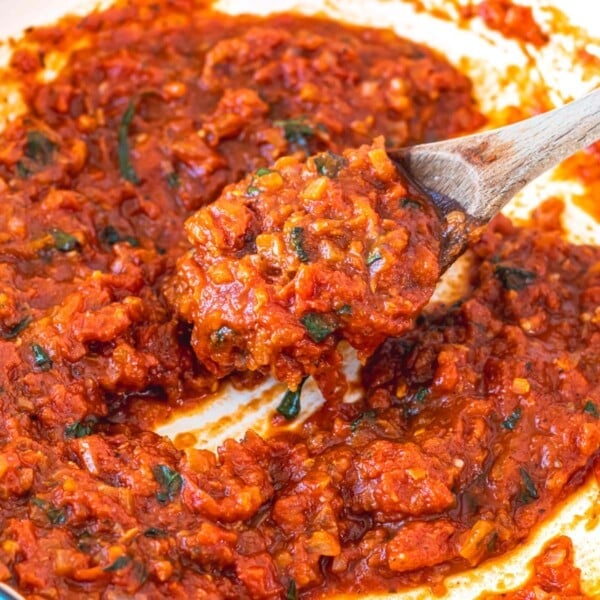
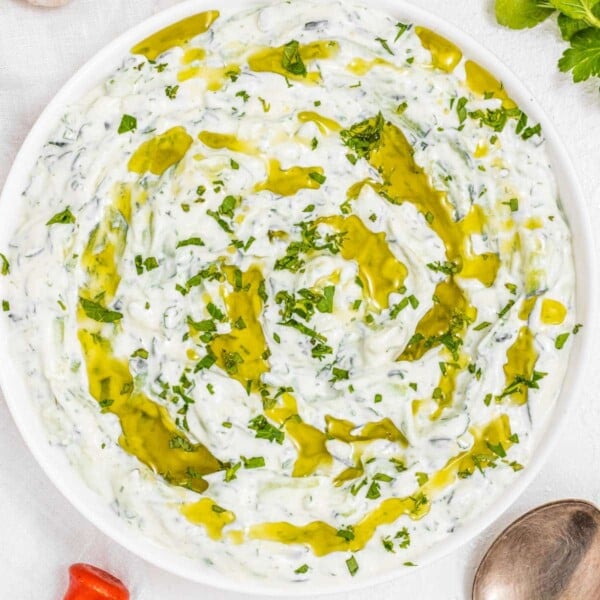
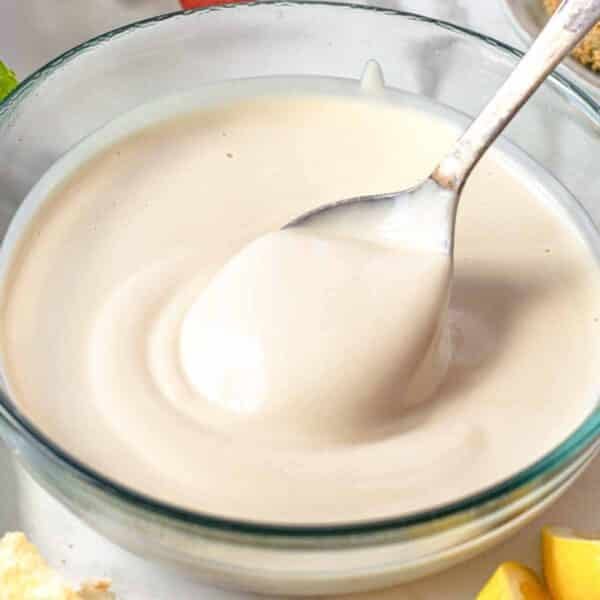
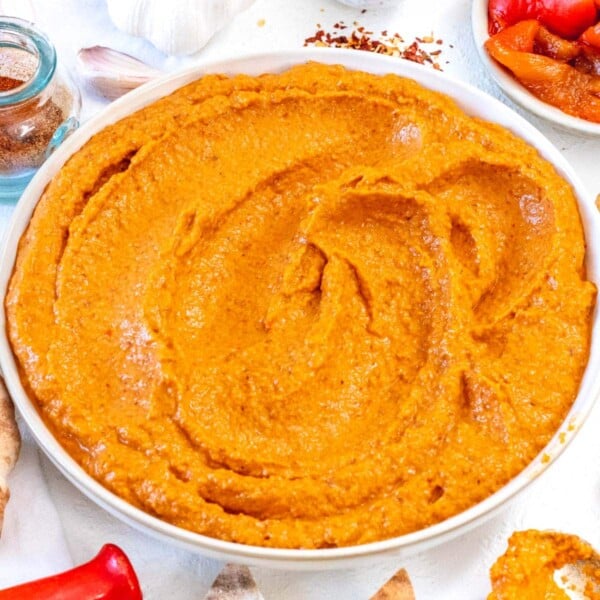

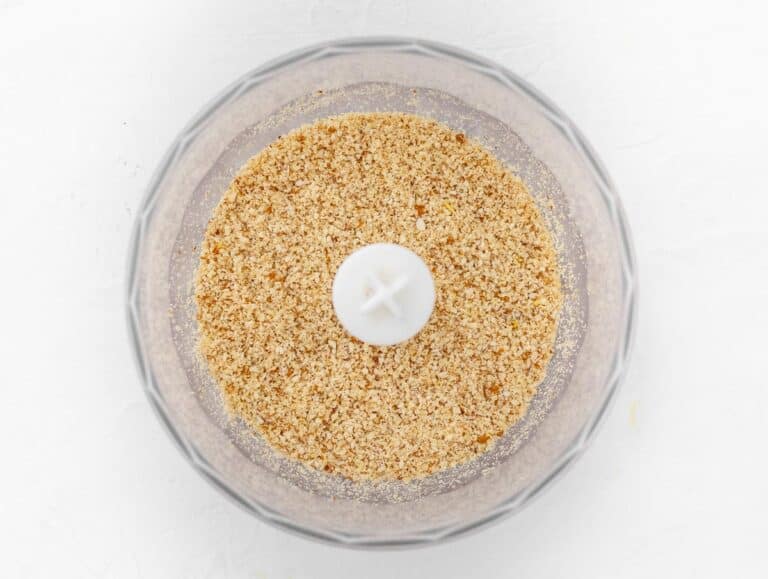
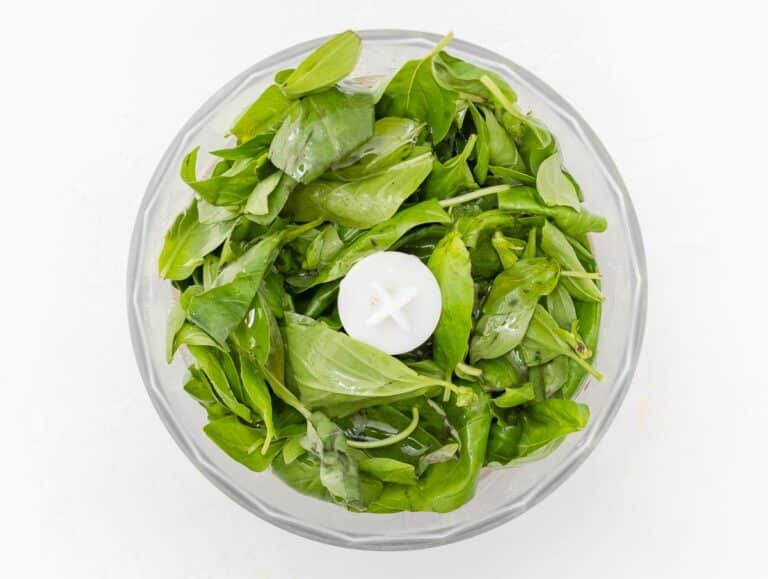
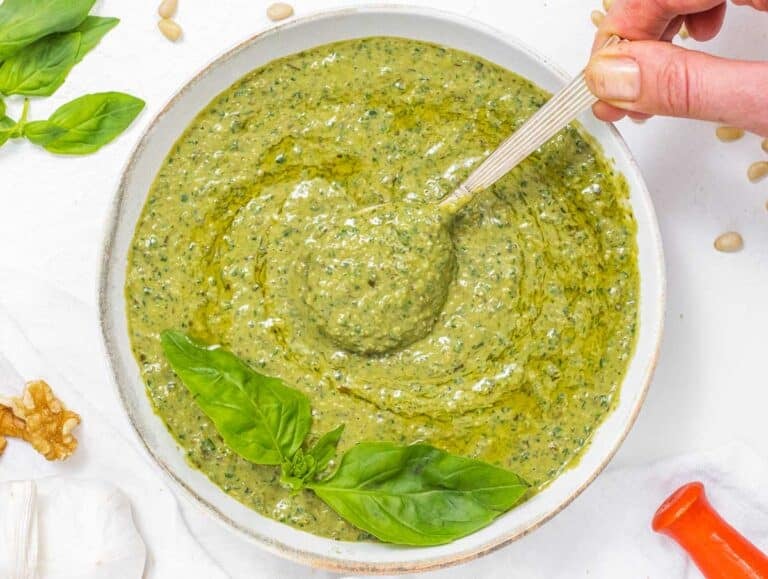
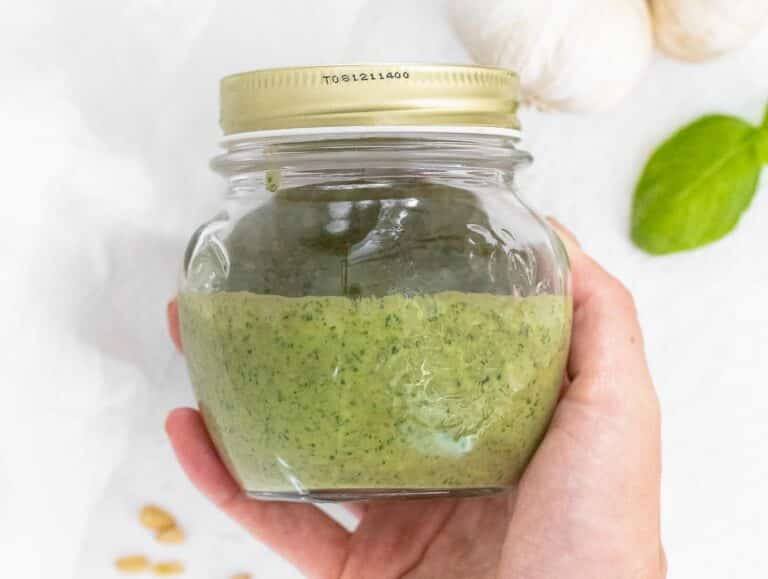
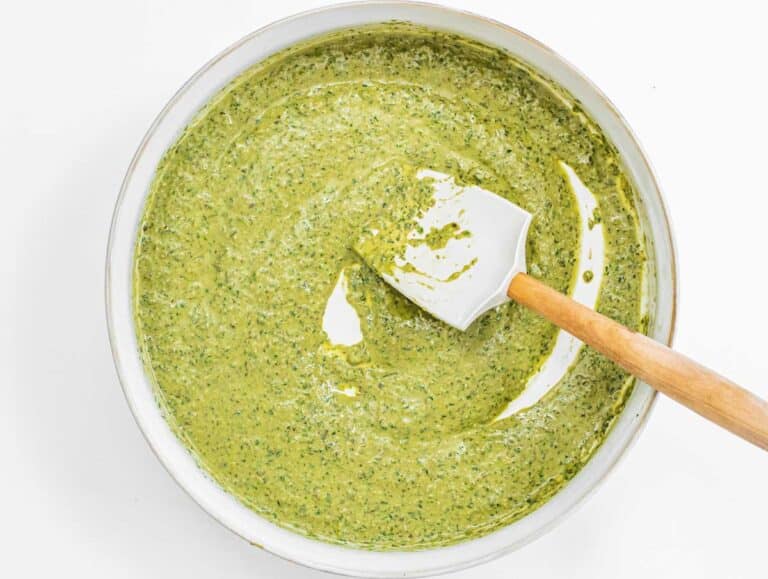
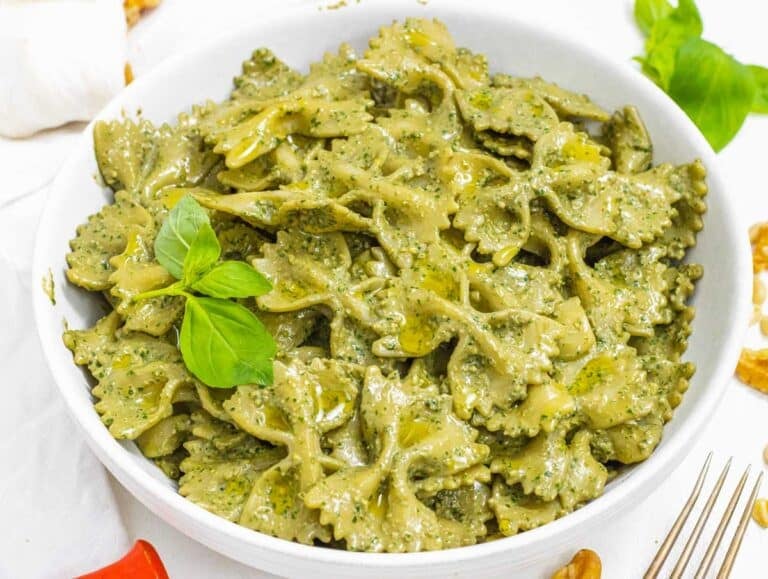
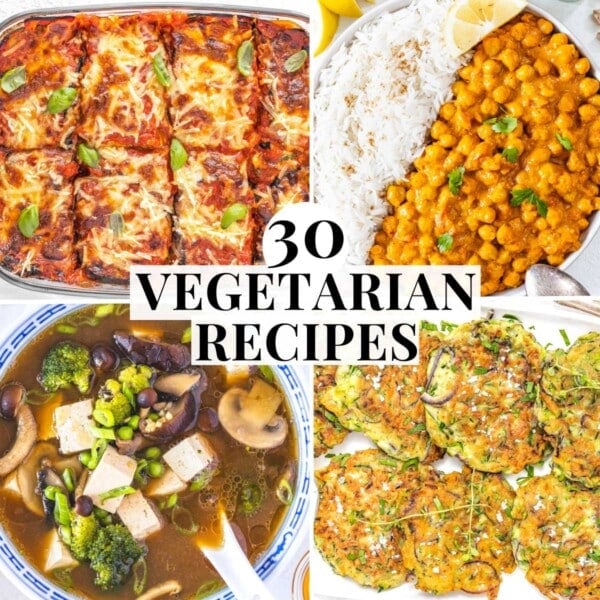
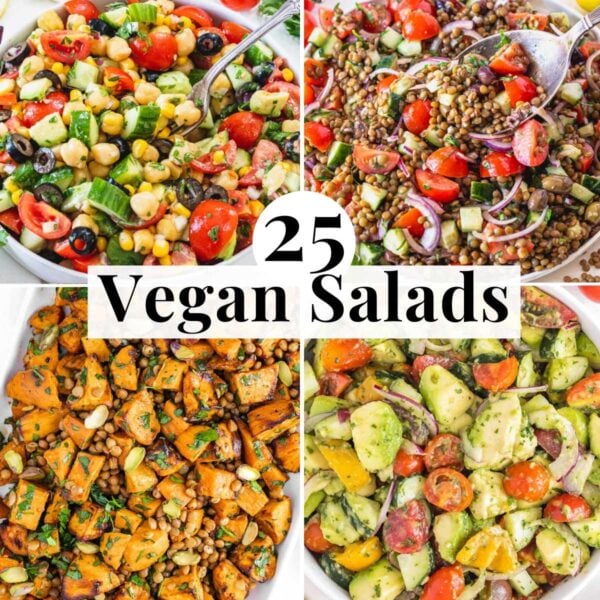
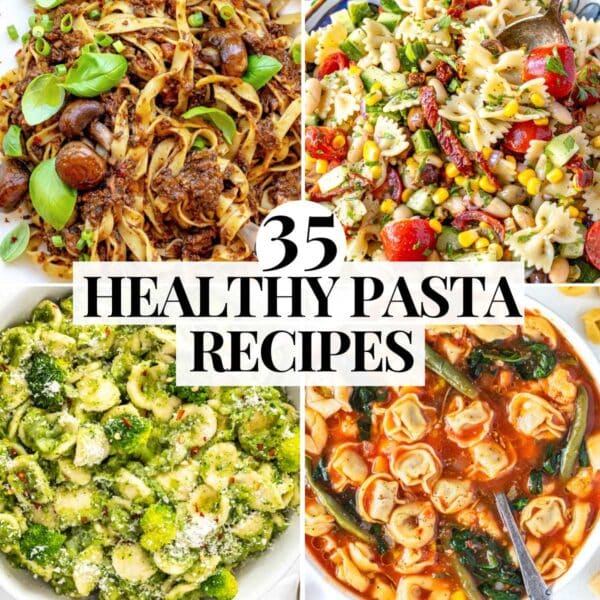
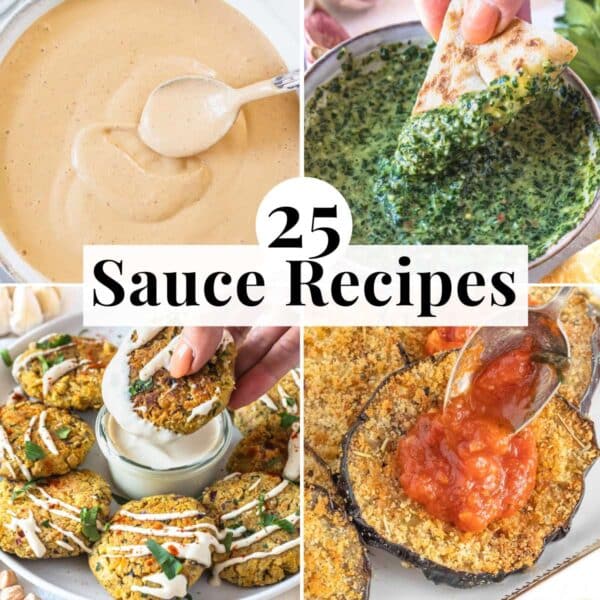

To make the pesto oil-free, it’s 1 cup macadamia nuts and leave out the oil and walnuts? The instructions before the recipe say no need for oil and almonds. Looking forward to trying this pesto.
Hi Karen,
Correct. You can substitute 1 cup of macadamia nuts for the oil+ walnuts/almonds. So yes, leave out the oil and walnuts.
It’s soo good! I hope you like it 🙂
Best,
Nico
Anxious to try pesto. Have vegan granddaughter so looking for vegan Italian recipes! Thank you so much
Nico, I’m from Italy but I live in Canada. THANK YOU from the bottom of my heart for posting authentic Italian recipes with North American measurements, I have made lots of your stuff and it’s all been great. This pesto tastes almost like my mom’s, except , of course, that she uses real cheese. The only change I made was that I only used pine nuts. Keep posting!
Ciao Lilia,
That’s fantastic, we’re so happy you liked the pesto and our recipes in general (it’s such a compliment that it reminds you of your Mom’s cooking).
Thank you so much for taking the time to write a comment, and warm greetings from both of us.
❤️ Nico & Louise
Hi,
One question about the nutritional yeast: referencing a few conversion sites I’ve found that 1 Tbsp is about 10 grams. You wrote 3 Tbsp in the USA version and 10 grams in the metric version, so I’m a bit confused whether I should use 10 or 30 grams. Thank you!
Hi Denise,
Thanks so much for your question. You should use 10 grams of nutritional yeast if you use a scale.
I double-checked with a precision scale, and 1 US tablespoon equals about 3.5 grams of nutritional yeast flakes.
I also triple-checked with Bob’s Red Mill Nutritional Yeast Flakes, which agrees with our volume/weight conversions on their package.
Maybe the conversion sites use a different yeast?! Or maybe they are inaccurate.
Hope this helps 🙂
Nico
Lovely recipe! A tip for people who find it hard to purchase nutritional yeast: I replaced it with a bit of miso paste for that savoury, umami flavour.
Tried the recipe and it is amazing. Also tried just on some crusty bread and it was delicious
Thank you Salim – I am so happy to hear that you liked the pesto! It’s a nice quick lunch and appetizer on good bread, I so agree. Thanks for taking the time to leave a comment! Cheers, Nico